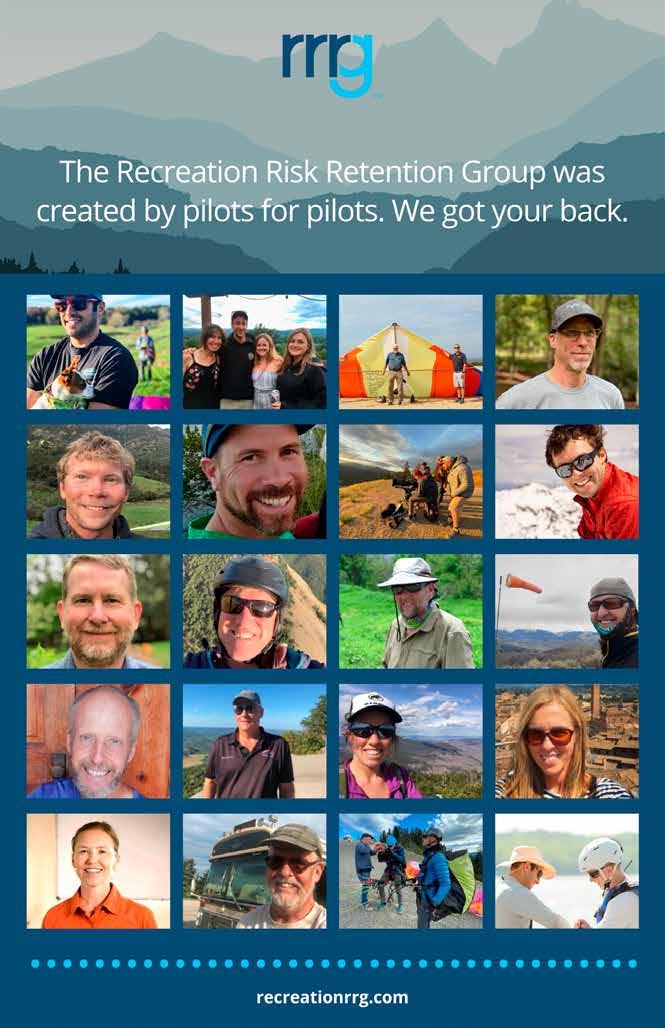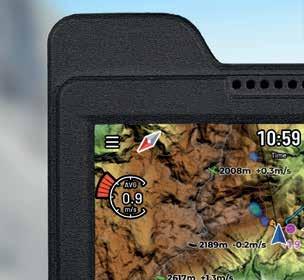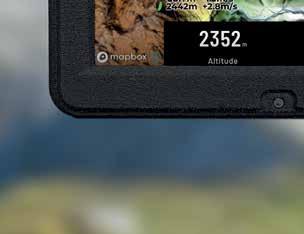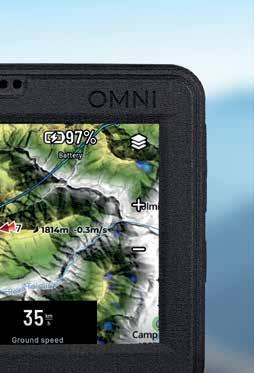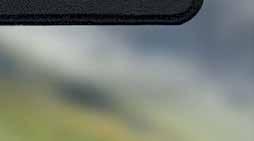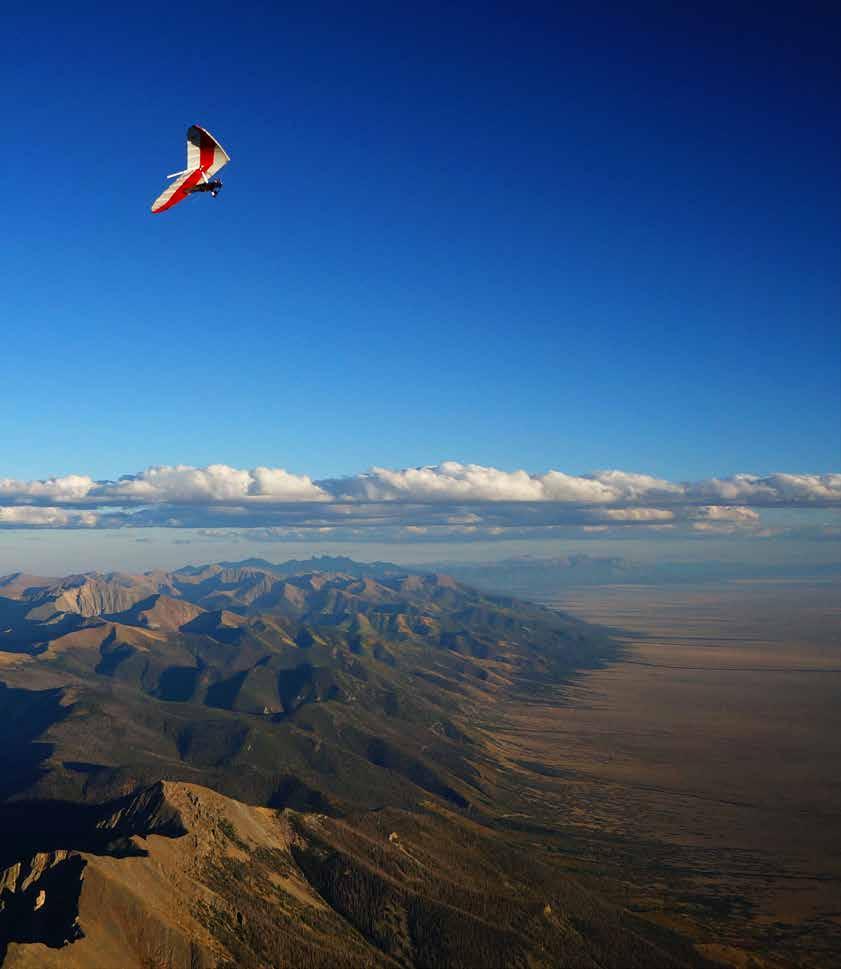
HANG GLIDING + PARAGLIDING + SPEEDFLYING
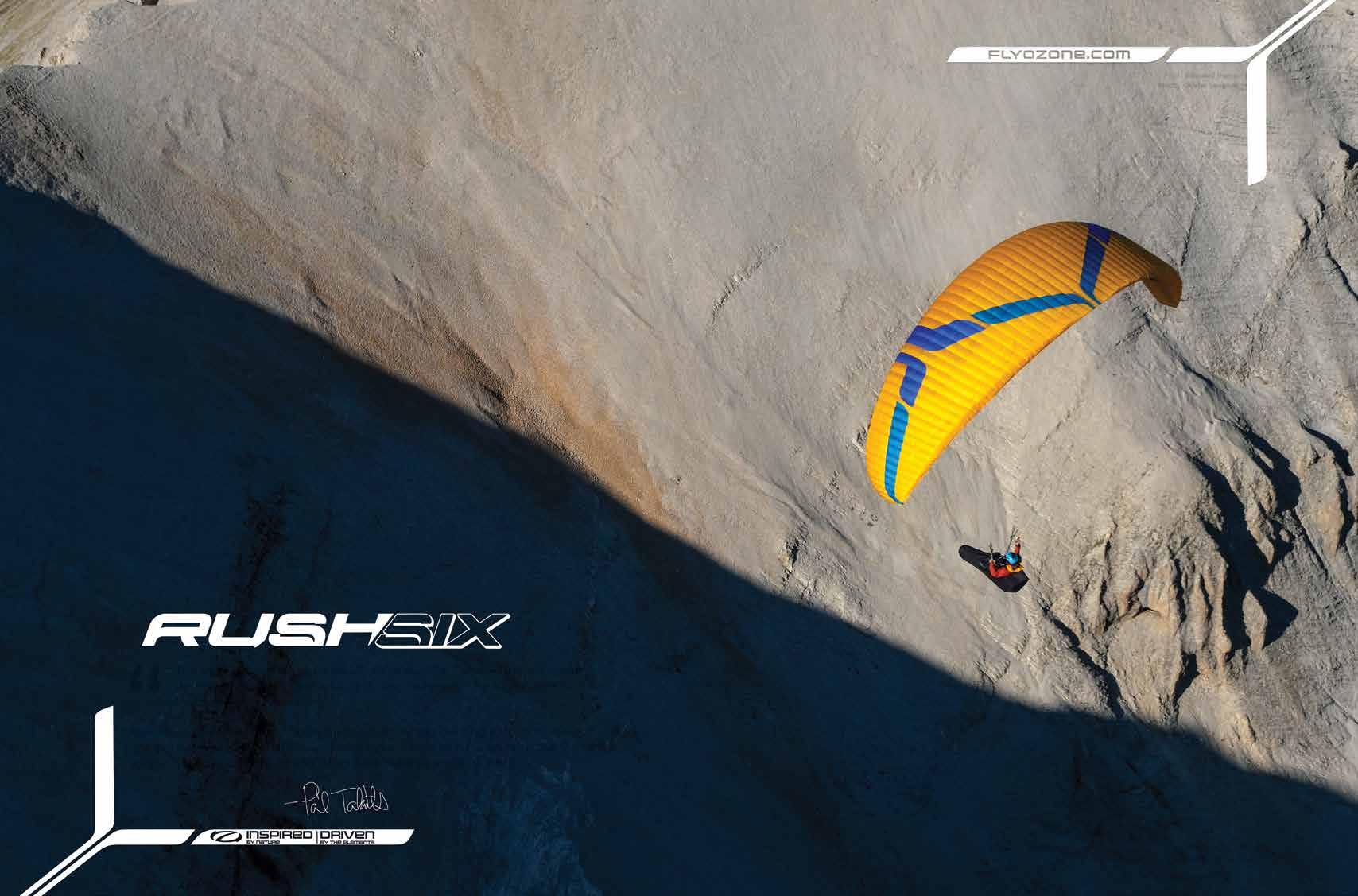




Cover Photo by Josiah Stephens A lucky pilot skying out near Villa Grove, Colorado.







Cover Photo by Josiah Stephens A lucky pilot skying out near Villa Grove, Colorado.
Association 6 Editor 8 Briefs 9 Ratings 62
USHPA Awards by Liz Dengler 10
Honoring the 2024 receipients
Accident Review Committee submission by Chris Mann 16
Preflight, preflight, PREFLIGHT!
Colombia Páramos by Riley Ferré 20
Exploring new hike-and-fly missions
Community Builders by Lindsey Ripa Burns 26
What it takes to throw a fly-in
Trip to Villa Grove by Jeff St. Aubin 32
A bi-wingal pilot explores a Colorado gem
Croak & Cluck cartoon centerspread by Harry Martin
Ice Lake by Arias Anderson 40
A Colorado speedflying mission
Windy Kiting Skills by Brian Petersen (with Erika Klein and Heather Harston) 46
Common windy kiting mistakes and tips for fixing them
Reviewing the Rapido 3X by Calvin Freeman 52
A versatile speedwing for advanced pilots
NorCal Cross Country League 2024 by Jugdeep Agarwal 56
Updates and results
Mistakes and Miracles by Dan Corley 58
HANG GLIDING, PARAGLIDING, AND SPEEDFLYING ARE DANGEROUS ACTIVITES
USHPA recommends new or advancing pilots complete a pilot training program under the direct supervision of a USHPAcertified instructor, using equipment suitable for their level of experience. Many of the articles and photographs in the magazine depict advanced maneuvers being performed by expert pilots. No maneuver should be attempted without appropriate and progressive instruction and experience.
©2024 US HANG GLIDING & PARAGLIDING ASSOC., INC. All rights reserved. No part of this publication may be reproduced, stored in a retrieval system, or transmitted in any form or by any means, electronic, mechanical, photocopying, recording, or otherwise without prior written permission of USHPA.
POSTMASTER USHPA Pilot ISSN 2689-6052 (USPS 17970) is published quarterly by the United States Hang Gliding and Paragliding Association, Inc., 1685 W. Uintah St., Colorado Springs, CO, 80904 Phone: 719-632-8300 Fax: 719-632-6417 Periodicals
Postage Paid in Colorado Springs and additional mailing offices. Send change of address to: USHPA, PO Box 1330, Colorado Springs, CO, 80901-1330. Canadian Return Address: DP Global Mail, 4960-2 Walker Road, Windsor, ON N9A 6J3.
Versatile by design www.nova.eu/ion-7

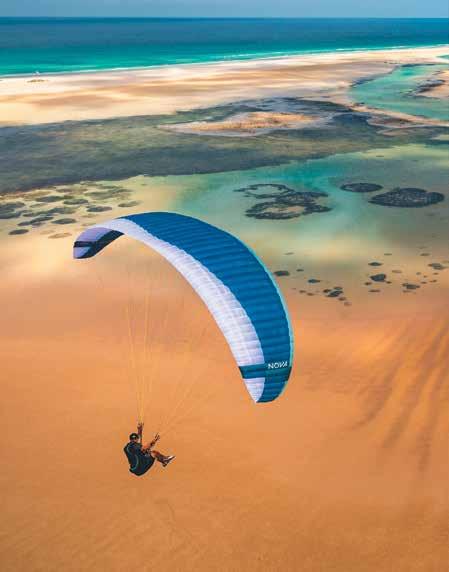




Do you have questions about USHPA policies or programs? Are there topics you’d like to hear more about?
EMAIL US AT: info@ushpa.org
Interested in taking a more active role supporting our national organization? USHPA needs your skills and interest.
VOLUNTEER AT: ushpa.org/volunteer
For other USHPA business +1 719-632-8300 info@ushpa.org
James Bradley, Executive Director
: Flying is magical, wondrous, and gives us so much. With good instruction, a conservative attitude, and an ordinary amount of luck, we can fly for decades without a serious mishap. Maybe.
We can mitigate the likelihood of a flying mishap by keeping more margin than we think we need, in every situation. Stay more in front of the ridge, farther from the big cloud, closer to the field, higher above the side valley, farther from the rock face, more aware of the valley wind, more ready to use the reserve, more willing to land in the safer place—or even not launch that day. Make extra margin part of your flying temperament and you'll need less luck. You might also find it doesn't diminish your enjoyment.
though it too goes out of date: cloudbasemayhem.com/insurance. If you're going to Switzerland, be sure and join Rega, which will cover your emergency helicopter ride: rega.ch/en
Please don’t fly without health insurance.
: You’ve probably heard dues are going up, for the first time in nine years, on April 2. If you Google “inflation calculator”, you’ll find the new pilot dues match 2016's in real dollars. It’s just another frustrating effect of inflation.
The United States Hang Gliding & Paragliding Association, Inc. (USHPA) is an air sports organization affiliated with the National Aeronautic Association (NAA). The NAA is the official representative of the Fédération Aeronautique Internationale (FAI), which is the world governing body for sport aviation. The NAA represents the United States at FAI meetings.
The NAA has delegated to USHPA the supervision of FAIrelated hang gliding and paragliding activities, such as record attempts and competition sanctions.
We can mitigate the consequences of a flying mishap by having health insurance. If people depend on you financially, consider also life insurance. Check your policies for aviation or adventure sports exclusions. If you're going abroad, make sure your insurance covers you there. Consider adding air ambulance repatriation, which will bring you back to a hospital near home. The insurance isn’t costly, the air ambulance is, and you don’t want to be stuck in a foreign hospital for months. USHPA partner MedJet offers USHPA members a discount: medjet.com/USHPA. If you want to add SAR and medical, be aware that policies and pricing change constantly. Cloudbase Mayhem has a webpage that can help,
: As a USHPA member, you're part of, and providing crucial support for, the only national organization in the U.S. that works every day to maintain and improve your flying experience and opportunities. You’re helping to build and support a vibrant national community of free flyers.
To this very end, we’re hard at work on several initiatives. I invite you to check out the strategic plan: go to USHPA.org/about and click the strategy link. Then send me your thoughts at james@USHPA.org
You also get a long list of member benefits, which you can see at USHPA.org/benefits.
: Do you have an experience, a frustration, or an idea you think I should know about? Please go to USHPA.org/meetwithjames. I look forward to speaking with you.

REGION 1
South Dakota
Washington Wyoming
REGION 2 CENTRAL WEST
REGION 3 SOUTHWEST Southern California Arizona Colorado New
REGION 4 SOUTHEAST Alabama
To deliver programs and services that support all our members, foster a community of skilled and knowledgeable pilots, and promote and protect the freedom to fly.
A vibrant free flight community across the United States.
Core values & guiding principles
Celebrate the spirit of discovery and the joy of being in the outdoors.
Support ongoing education, development of skills, and acquiring of the judgment that comes from experience and attention.
James Bradley Executive Director james@ushpa.org
Charles Allen President president@ushpa.org
Kirby Ryan Vice President vicepresident@ushpa.org
Olga Grunskaya Secretary secretary@ushpa.org
Pam Kinnaird Treasurer treasurer@ushpa.org
Galen Anderson Operations Manager office@ushpa.org
Chris Webster Information Services Manager tech@ushpa.org
Anna Mack Program Manager programs@ushpa.org
Maddie Campbell Membership & Communications Coordinator membership@ushpa.org
BOARD MEMBERS (Terms End in 2025)
REGION 5
Be stewards of our natural places, our flying sites, and the future of our sport.
Act ethically, take 100% ownership, communicate clearly, respond effectively.
Foster a considerate community free from harassment and abuse.
Kirby Ryan (region 3)
Nelissa Milfeld (region 3)
Pamela Kinnaird (region 2)
Olga Grunskaya (region 5)
Bob Ferris (region 3)
BOARD MEMBERS (Terms End in 2026)
Van Spurgeon (region 3)
Charles Allen (region 5)
Nick Greece (region 2)
Stephan Mentler (region 4)
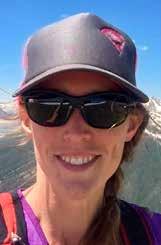
Liz Dengler
Managing Editor editor@ushpa.org
Julia Knowles
Copy Editor
Greg Gillam Art Director
WRITERS
Dennis Pagen
Lisa Verzella
Erika Klein
Julia Knowles
Do you have a story idea you would like to pitch? We are always looking for stories.
EMAIL LIZ AT: editor@ushpa.org
Are you ready to contribute a complete story? We are always looking for articles, photography and news.
GET STARTED AT: ushpa.org/contributors
All articles, artwork, photographs as well as ideas for articles, artwork and photographs are submitted pursuant to and are subject to the USHPA Contributor's Agreement , which can be reviewed on the USHPA website or obtained by emailing Liz.
Would you like to run an advertisement ? Great!
CONTACT US AT: advertising@ushpa.org
: One of the benefits of your USHPA membership is this magazine, which gives back to the community in a few ways. Besides highlighting the stories of our members in this publication, we also pay our published contributors. We’re always on the lookout for stories from our members. Travel, tips, hang gliding stories, home site reports, the mental game, gear reviews, and more! Whatever you’re excited to share with the community, we probably have a home for it. Send a pitch my way: editor@ushpa.org
In this issue, pilots share compelling pieces covering a wide range of topics. We start by honoring the 2024 USHPA award recipients. Each year, USHPA issues awards and commendations to members who make contributions to our sport, often recognized by their peers. These pages contain some touching quotes from nominators, and they’re worth a read. As you read through the awards list, consider nominating someone for 2025!
Two brave members have come forward with articles about their accidents. One was fueled by complacency and failure to complete a full preflight check. The other resulted from a healthy dose of hopium and trying to force a flight in inappropriate conditions. We applaud both pilots for sharing their stories, which helps promote a culture of openness and safety across our community."
Three members discuss their travel experiences on missions to explore new places. From a hang glider’s first
time to the legendary Villa Grove, Colorado, to hike-and-fly treks of Colombia’s remote gems, to a backpacking mission to speedfly over the stunning Ice Lake in Colorado, these authors do a masterful job crafting their tales. I’m certainly excited to start planning my own summer adventures!
Intermission is provided by the delightful Croak and Cluck—darlings and misfits of the hang gliding and paragliding world. Flip to the centerfold to chuckle at their misadventures.
A gear review of a newly-beloved speedwing for advanced pilots keeps potential buyers in the know; tips for kiting in high wind from experts at the Point of the Mountain, Utah, can prepare members for when conditions start to pump up. Both stories showcase great photos that capture the essence of each story.
The last two articles focus on running events and supporting the community. You will find an expert recap of the Northern California leagues (something I wish we had where I live) and a thoughtful breakdown of what it takes to plan and run a fly-in.
Enjoy the issue. With the sheer diversity of experiences and perspectives packed into these pages, you may have to read it twice!

NOVA BION 3
The BION 3 is aimed at professional tandem pilots. It features an easy takeoff along with great turning characteristics. It’s 40.68m with a weight range from 110 to 220kg. The BION 3 certifies EN-B and weighs 6.8kg. It comes in three colors and is available through Super Fly with your choice of bags. www. superflyinc.com +1 801-255-9595 or your local dealer.
The legendary SIGMA is born again with the SIGMA DLS (EN-C). The redesigned internal structure is still durable but light (3.7kg). Features include Nitinol mini-ribs to maintain leading edge shape at speed and the pitch control system, which keeps a clean profile when C-inputs are given. It comes in five sizes, from 57 to 128kg, at an aspect ratio of 6.1. It comes with a COMPRESSBAG DLS but also comes with the pilot’s choice of concertina, light rucksack, normal rucksack, or fast-packing bag. Available through Super Fly: www.superflyinc.com +1 801-255-9595 or your local dealer.
Naviter is introducing SeeYou Navigator 3.2. featuring an improved Thermal Assistant with Thermal Bubbles that provide a more intuitive thermal detection to help you climb faster. Fine-tune your navigation display with a configurable snail trail length. Also included in v3.2 is an upgraded FAI triangle assistant that ensures precision when completing your tasks. Plus, a new wind calculation algorithm delivers more accurate real-time data for better decision-making. This update also includes crucial bug fixes, ensuring smoother, more reliable performance. Available now for your Oudie N, Omni, iPhone, or Android. For more info: www.flytec.com | info@ flytec.com | +1 800-662-2449
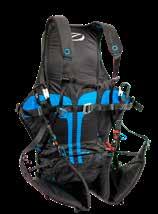

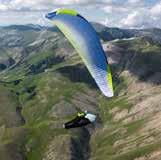



ATAK 2
The Atak 2 harness is a purpose-built speedflying harness designed by top pilots to meet the unique needs of the sport. It combines multi-season versatility with a lightweight, compact, and durable design. The Atak 2 is suitable for all levels, from new pilots to expert speed riders. It is optimized for comfort and precision while kiting or riding in upright positions, offering ultra-smooth transitions from standing to sitting. www.flyozone.com
The Camino 2 is easy to launch, has smooth handling, and best-in-class 2-liner performance. It has an aspect ratio of 6.3 and features the wave leading edge, which provides better stability at speed. It is light and compact and can be packed in a compress bag. The Camino 2 only weighs 3.9kg in the medium size. It is available in five sizes from 60 to 125kg. Available through Super Fly: www.superflyinc.com +1 801-255-9595 or your local dealer.
The latest in the LIGHTNESS series harness has slightly better comfort, handling, and looks while preserving all the great LIGHTNESS 3 qualities. It has 35% more storage, a new cockpit design, and it comes with a hook knife, windshield, and LIGHTPACK DLS. It comes in three sizes and accommodates pilots from 155 to 200cm. It weighs 3.47kg in the medium size. Available through Super Fly: www.superflyinc.com +1 801-255-9595 or your local dealer.
: Each year, USHPA honors exemplary pilots and community members with the USHPA awards. These themed awards and commendations show our appreciation for those who have contributed significantly to the free flight community.
Chris Santacroce
Presidential Citation
From 2024 USHPA President Bill Hughes: Though USHPA is professionally managed by a small handful of dedicated employees, it relies heavily on pilot and instructor volunteers who give up significant chunks
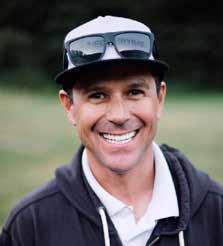
balanced perspective to many of the tough subjects we tackle. As an administrator, instructor, tandem pilot, and school operator, Chris understands the demands placed on each group. However, he also sees things from the FAA/USHPA perspective of what is required to safeguard the future of free flight in the U.S. He was instrumental in the insurance transition, and last year he helped us craft important messaging to drive cultural change after some issues with waiver compliance that had the potential to jeopardize our tandem exemption.
Please join me in congratulating Chris on the award
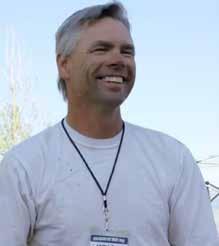
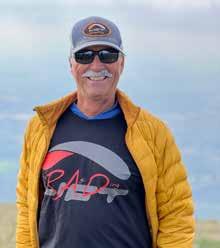
L to R: Chris Santacroce (Presidential Citation), Larry Smith (Exceptional Service), David Blacklock (Paragliding Instructor).
of their personal time to further USHPA’s mission and to protect and grow free flight for all of us.
Few people in USHPA’s history have done as much to grow the sport or contributed as much as a volunteer as 2024’s Presidential Citation Award winner, Chris Santacroce. He has long been a driving force in training and certification and increasing pilot safety. He has been central to our efforts to collect data, analyze, and report on accidents. He’s also contributed significantly to setting standards and guidelines for tandem flights and tandem instructor appointments. Last year, Chris was chair or co-chair of three different USHPA committees. He brings a unique and
and thanking him for his ongoing work to support USHPA’s mission. Chris is a role model for what a member of the USHPA community can be.
This award recognizes any member or non-member’s outstanding service to USHPA during the year. An individual may receive this only once, and in 2024, the Awards Committee recognized Larry Smith. Larry has been an integral part of the free flight community for many years. Steward of the legendary site at Villa Grove in Colorado, Larry has gone above
and beyond to ensure its access. Hosting annual organized events, casual fly-ins, and a revolving door of visitors, Larry has introduced numerous pilots to flying in this area. Nominators were quick to mention his helpful nature and willingness to host groups at his property (adjacent to the LZ) during flying events. Thank you, Larry, for your care and attention in keeping Villa Grove an amazing site for hang glider and paraglider pilots alike.
Paragliding Instructor of the Year
With an overwhelming number of nominations, David Blacklock has been awarded Paragliding Instructor of the Year. His students have universally noted his kind, patient, and calm demeanor. “With his patience, supportive nature, and willingness to go the extra mile, David possesses a rare combination of qualities that make him an outstanding paragliding instructor,” said one nominator. “He is not only a skilled pilot with a deep understanding of the sport, but also a gifted teacher who can convey that knowledge effectively.”
Another nominator commented, “Dave combines keen perception and a watchful eye with a willingness not only to meet students at their current level of participation and understanding, but also to adapt to their particular learning style and method of engagement.”
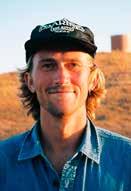
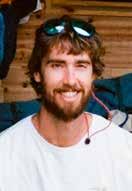
Dave also seems to have a knack for teaching through stories and humor, as numerous former students commented on his ability to inject humor or personal anecdotes into their lessons. “He is a gifted storyteller who never fails to inspire new students or put a smile on the face of a pilot frustrated or embarrassed by that last flight,” offered one pilot. It’s clear this award is well-deserved. Congratulations, David!
Brady Mickelson, Jens Bracht, Barry Barr, Tyler Lee, and Dan Homes
Best Promotional Film
This award is granted to the filmmaker(s) whose work is judged best by the Awards Committee after considering aesthetics, originality, and a positive portrayal of the sport. In 2024, the recipient was the KAVU short film: “Forever Busy Livin’. ”
One nominator described the film as “…a touching short about two of the kindest and longest-enduring people in our sport.” C.J. and George Sturtevant have been USHPA members for more than 43 years! “KAVU, a Seattle-based clothing company, made a heartwarming feature about our O.G. royal couple of free flight,” another commented. “The film deftly highlights their deeply entrenched love of each other and their shared thirst for adventure by highlighting their incredible journey across the world over the last four decades under hang gliders and paragliders.
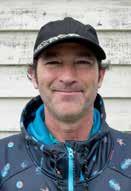
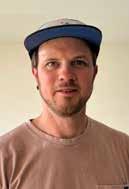



The film sweetly shows a life well lived and how the beat still plays on for two amazing members of our organization.”
The leader behind the movie, Brady Mickelson, had this to say about filming the project: “It was incredibly fun hanging out with C.J. and George for four days. They made us dinner from their garden, C.J. baked some killer macarons, and we learned the term MUSTGOS (aka: leftovers or food in the fridge that needs to be eaten).” He continued, “I also want to give a shout-out to the KAVU crew for investing in storytelling and letting me run with it. It’s pretty rare these days for companies to do this. Big love to Barry, Dan, and Tyler.”
When I reached out to C.J. to get her take on the film, she had this to say:
When Nick [Greece] first told us that KAVU wanted to do a short documentary about us, we were puzzled: Why us? I’m not typically comfortable being the center of attention. But Nick assured us it would be fun. So, in September of 2023, two young men and all their video-making gear showed up on our doorstep, and indeed, the fun began. We dug through and told the stories behind decades-old flying photos and slides. We drove and biked to paraglider sites and pickleball courts while Brady and Jens filmed. They chatted with and filmed our friends and neighbors. And then they left, and we still had no clear idea when we’d see a finished product, but Nick was right: The process was great fun!
It wasn’t until we were on a paragliding trip in Mexico and a paraglider pilot working on her computer in the LZ where we were packing up kept looking

over at us, then back at her computer, then back at us, hollered over, “Are you C.J. and George?” that we finally saw the video. And it blew us away! Brady and Jens took all those bits and pieces, images and chats, and turned them into this amazing portrayal of our lives together. We still have no idea why KAVU chose to sponsor the creation of a video about us, but we’re grateful to them, Nick, Brady, and Jens for this beautifully crafted story.
For those of us who have watched the film and heard the legendary tales, we know why they chose C.J. and George. Your lives together and paragliding careers are an inspiration to all of us, and we thank you for letting your story be told. You can watch “Forever Busy Livin’ ” on KAVU’s website here: adventure.kavu.com/cj-forever-busy-livin or via YouTube: www.youtube.com/watch?v=ifWS5SIpycM
Finding a mentor can be a challenge to those new to the sport. Luckily, the pilots of Ellenville, New York, are never at a loss, thanks to Rick Fitzpatrick. “He is incredibly generous with his time with me, and took me under his wing in a way that I hadn’t experienced since my youth,” said one nominator. Rick is quick to donate his knowledge to local pilots and visitors alike, and is always generous with his time to ensure safe flights and good experiences. “Both days that I flew Ellenville, Rick spent the whole day on the mountain, waiting until the evening when the wind calmed down enough to launch. He didn’t fly either of these days but was completely happy to advise and
Richard Fitzpatrick
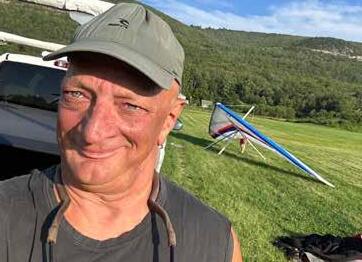
years of flying experience, graciously helping both new and experienced pilots reach their goals. This eagerness to share his local flying site and his knowledge is a huge boost to the sport of hang gliding,” said another pilot. Rick goes above and beyond to support the growing community of pilots. Another nominator mentioned, “Rick came to Ellenville in 2020 and tirelessly helped at launch and picked students up from the LZ to let them get multiple sled rides until they were ready for soarable air.” Rick continues to support and mentor pilots as they progress in the sport. Numerous pilots owe at least some of their progression to him. Thank you for all you do for the community!
Philippe Renaudin is an enthusiastic teacher, dedicated mentor, and devoted pilot. He is an integral part of the free flight community. He always ensures his students are prepared, and safety is his priority. One nominator commented, “With over three decades of experience since 1990, he has trained countless individuals, fostering a strong community of skilled paragliders. His leadership in founding the first paragliding club on Long Island in [the early 2000s] shows his commitment to expanding and promoting the sport, creating a lasting impact on the paragliding community.”
Many others were quick to speak to Phillippe’s dedication to teaching students. “Phil teaches with gen-
MAKE YOUR NOMINATION AT: ushpa.org/awards
NOMINATIONS ARE DUE OCTOBER 1.
PRESIDENTIAL CITATION - USHPA's highest award.
ROB KELLS MEMORIAL AWARD - Recognizes a pilot, group, chapter or other entity that has provided continuous service, over a period of 15 years or more.
USHPA EXCEPTIONAL SERVICE AWARD - Outstanding service to the association by any member or non-member.
NAA SAFETY AWARD - The NAA presents this award to an individual, recommended by USHPA, who has promoted safety.
FAI HANG GLIDING DIPLOMA - For outstanding contribution by initiative, work, or leadership in flight achievement.
FAI PEPE LOPES MEDAL - For outstanding contributions to sportsmanship or international understanding.
CHAPTER OF THE YEAR - For conducting successful programs that reflect positively upon the chapter and the sport.
NEWSLETTER/WEBSITE OF THE YEAR (print or webbased).
INSTRUCTOR OF THE YEAR AWARD - Nominations should include letters of support from three students and the local Regional Director. One award per sport per year may be given.
RECOGNITION FOR SPECIAL CONTRIBUTION - For volunteer work by non-members and organizations.
COMMENDATIONS - For USHPA members who have contributed to hang gliding and/or paragliding on a volunteer basis.
BETTINA GRAY AWARD - For the photographer whose work (three examples needed for review) is judged best by the committee in aesthetics, originality, and a positive portrayal.
BEST PROMOTIONAL FILM - For the videographer whose work is judged best by the committee in consideration of aesthetics, originality, and a positive portrayal.
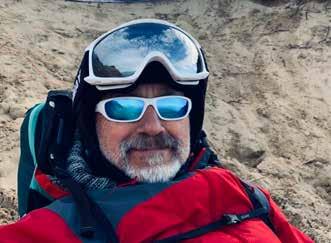
uine enthusiasm and great care for his students. He emphasizes safety and solid skills and is a pleasure to be around,” another offered. Thank you, Philippe, for your dedication and service to the sport.
The Hudson Valley Free Flyers Club leadership has worked incredibly hard to support their community of pilots at the Ellenville Flight Park. Together, they endeavored to purchase the Ellenville Flight Park from its private landowner. Though the sale eventu-
ally halted (due to an unanticipated decision by the landowner), the team worked tirelessly for months to the brink of success. The nominator stated, “Their work established a model for similar efforts to secure flying sites.”
The leadership team included Wayne Neckles, Brian Herbert, Shani Schechter, Brian Vant-Hull, Kenneth Foldvary, James Donovan, Michael Strother, Tony Davis, Jane Lenard, and Paul Voight. The team raised all necessary funds for the purchase and maintenance of the property, kept the community well-informed throughout the process, worked with additional entities such as state and town officials to ensure an efficient process, and, after the sale setback, continued to look beyond Ellenville to consider other sites in the region that could be opened or preserved.
“USHPA members should commend this team of leaders for their innovation, inspiration, unified effort, and engagement of the Ellenville hang gliding and paragliding community in a noble cause,” a nominator stated,
I couldn’t have said it better myself. We thank each of you for your incredible efforts and for sharing your enthusiasm.
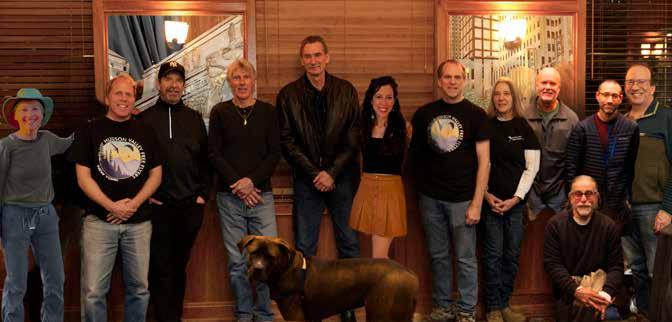
Get the gear that fuels your passion at discounted prices.
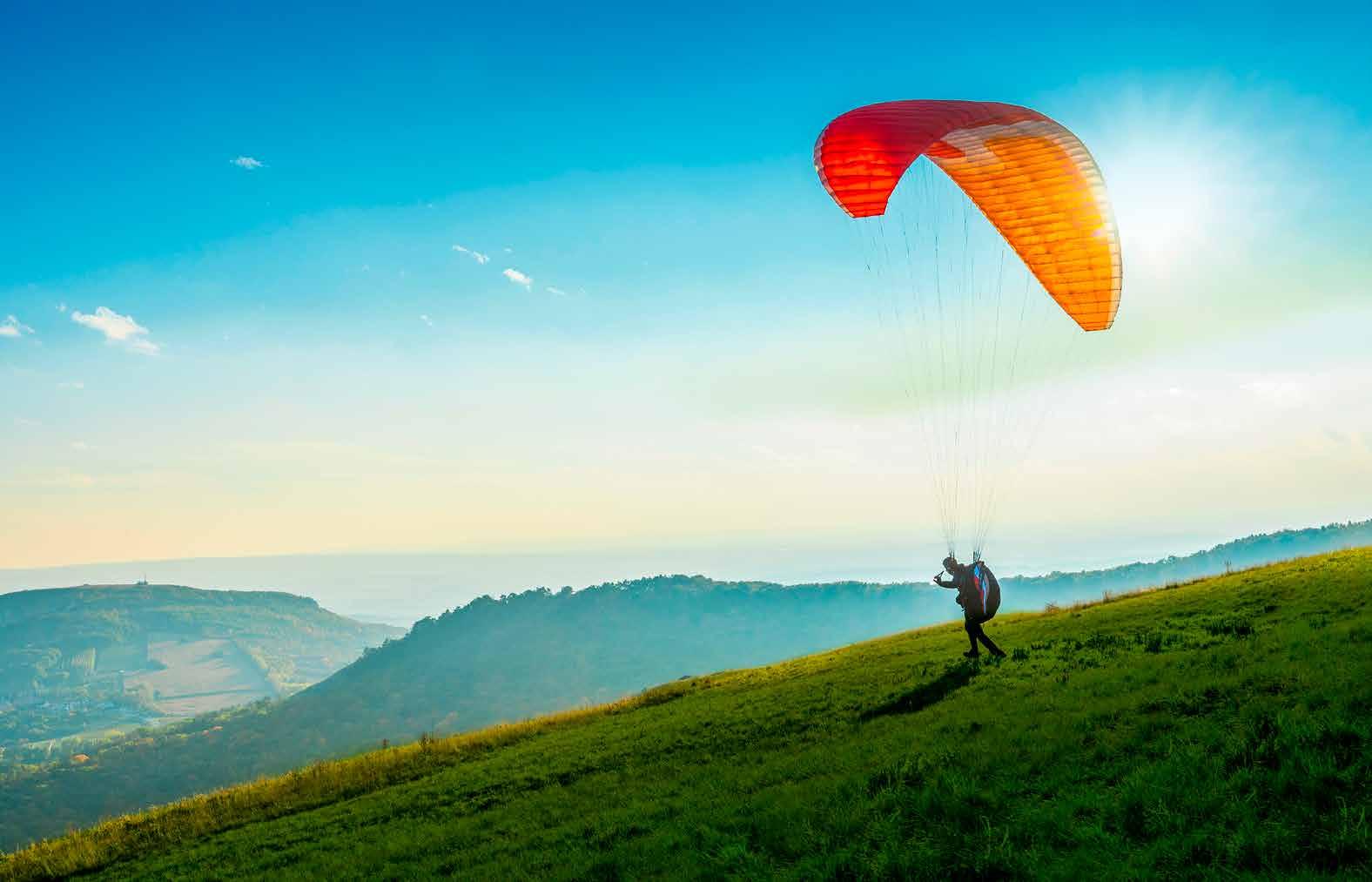

Your Pilot or Instructor USHPA membership automatically qualifies you to join. Simply scan the code to get started.
Unlock up to 60% o on top outdoor brands

So that others may learn from his mistakes, P4 pilot Chris Mann has shared the following incident.
Years flying: 3
Flight hours: 360
Thermal flight hours: 300+
Wing: BGD Lynx 2
Harness: Air Design Sock SL
Location: Big Walker, Virginia
Date: Oct 8, 2024 @ 1:30 p.m.
WX: Light meteo winds with thermals, 5-8 mph
: Recently, I went to fly at a new site with pilots I had never flown with before. I was the last of three to launch, rushed but confident. After bringing up my wing and kiting for a few seconds, I turned and launched.
A second or two after getting into my pod, I felt and heard a pop and immediately noticed my right riser floating in the air above my head, brake toggle still in my hand.
My immediate thought was, “I need to crash back into the hill.” In the milliseconds that followed, I noticed no significant change in my flight path, though I’m sure there was some. Within a second or two, I started turning to the left. I’m assuming this probably was not due to any input from me but simply what a wing connected via only one riser does naturally. I came down onto the hill approximately 20 feet below where I had launched,
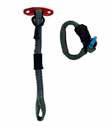

through a briar patch and onto a large rock. The impact burst the harness’s airbag. I was fortunate to walk away with only a busted lip and an extremely sore tailbone.
I believe I failed to fully close the soft link that holds the riser to the harness. The events suggest it was partially closed, as the riser stayed attached while kiting and immediately after launch for a few seconds. The risers were attached to the harness in the reverse launch position. After placing the right riser on the right soft link, I immediately moved on to place the left riser on the left soft link. I believe I failed to go back and fully close the right soft link.
A lackadaisical and overconfident approach to the day, brought about by having flown about 50 hours over the previous month at much more challenging launches and in more challenging conditions.
• Radio chat while setting up to launch.
• Chatting with spectators while setting up to launch.
• A lack of currency with this harness, which I hadn’t used in a couple of weeks.
• Long driving days on the days immediately prior.
• Pressure to get in the air to chase others.
• Soft links have no self-closure, as seen with carabiners.
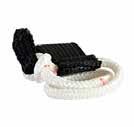
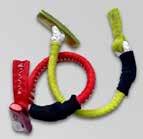
Images show the varieties of soft links. If you choose to use them, make sure you know their lifespan, limits, and how to properly secure them.
1. Preflight check, preflight check, preflight check! My normal preflight check goes from patting my bottom to ensure protection is inflated, then checking helmet strap, chest strap, leg loops, riser connection, and reserve. To assure a successful check, maintain a “sterile cockpit” while doing preflight checks and preparing to launch. If preflight is interrupted, start over.
2. Attach risers to the harness using auto-closing and locking carabiners. I don’t feel the minimal weight savings of soft links are worth the risk.
3. Take every launch and flight seriously.
In recent years, our culture has encouraged us to be self-reliant and do systematic preflight checks each time we fly. Alas, preflight errors do occur. In most cases, the story is that the pilot DID do a preflight
but that something happened along the way. This is why buddy checks are so essential and have been a critical cornerstone of our culture since the infancy of our sport.
None of us can be 100% on our preflights 100% of the time. Statistically, our odds of missing an item go way down when we bring in another set of eyes. Some oversight from a different vantage point can often help to spot one or two things that have been overlooked. Sometimes, it’s as simple as zipping up an open pocket. Other times, the buddy can find something out of place that can literally save the day.
Thanks for being a good flying buddy to all of your friends. Decades into your flying experience, you can take a huge sense of pride in having been a good buddy.

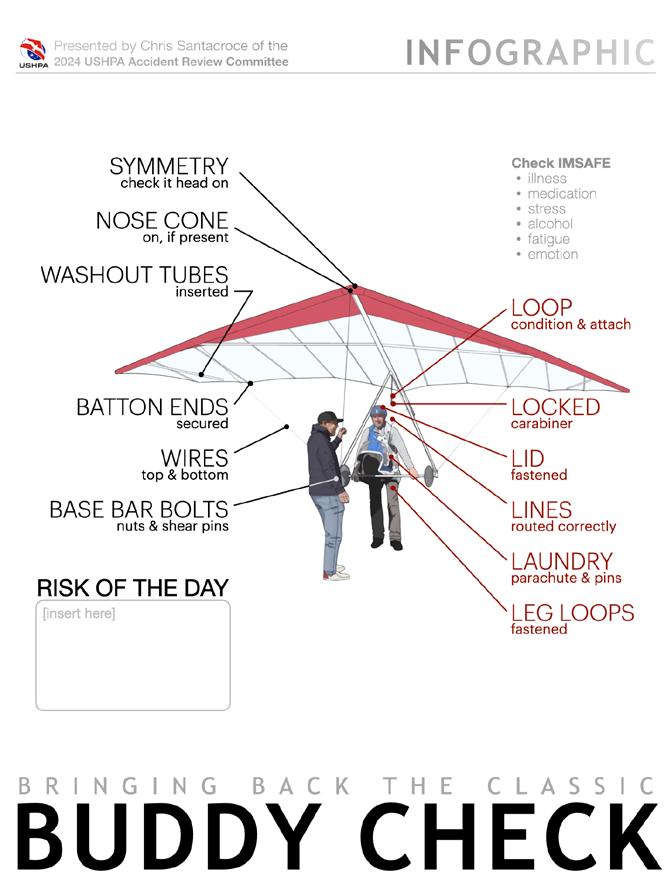

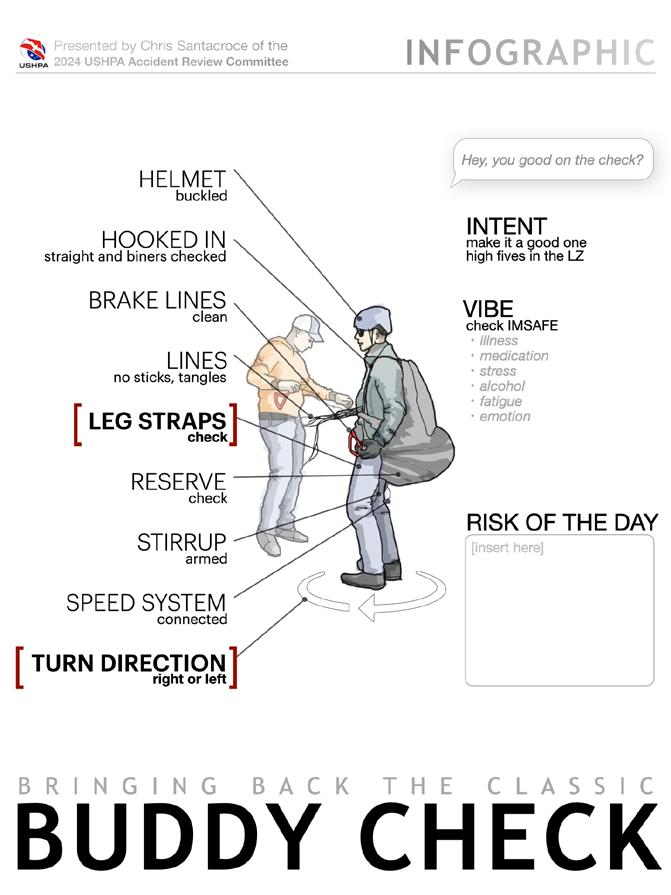
by Riley Ferré
: For years now, Colombia has served as one of my home bases. I first arrived in 2022 to study abroad, with little knowledge about the country other than its exceptional paragliding conditions. I flew more than I studied and fell in love with the culture and its abundant energy, the mountains, and the tropical sky. During the peak flying season, I work as a cross-country tour guide. I have had countless opportunities to immerse myself in the country, its people, and its landscape during the off-season as well. There is so much more to Colombia than most people are exposed to throughout the three-month paragliding season. The Andes of Colombia, Peru, and Ecuador are the only mountains with the unique el páramo ecosystem, which can be found between 3,000 and 4,500 meters above sea level. Los páramos are extremely important ecologically, consisting of abundant water, golden mosses, and a magical plant called el Frailejón which

only grows about one centimeter per year. Every time I hike up to a páramo, I am awestruck by the magic of this ecosystem, which is easy to compare to a fairyland.
From October to December 2024, I was fortunate enough to hike and fly from several of Colombia’s páramos from which only a handful of pilots had launched previously. I am a competition pilot and consistently fly throughout the year. This diligence allows me to embark on flying adventures that demand a higher skill level. I would only encourage pilots to commit to such plans once they are confident in their physical and mental strength as both an athlete and a pilot.
On every mission, I was accompanied by one of Colombia’s best-known hike-and-fly pilots, Alex Villa. Alex has pioneered most of the country’s routes and is a trained mountain guide. Hiking and mountaineering are not as developed in Colombia as in Europe or the United States, requiring proper preparation and the company of an experienced guide. It is strongly recommended that you seek local advice if you plan a trek into Colombia’s mountains.
Our first adventure took us to El Cerro San Nicolás, located in Los Farallones del Citará in the Antioquia region. The hike up this mountain was challenging, especially when carrying packs full of gear to spend a night at the top and fly down the following morning. The trail was incredibly steep and included several passes that required the assistance of ropes and tree roots. It would be best described as a climb or scramble rather than a hike.
Leaving at 9:00 a.m., we hiked about seven kilometers, climbing 2,168 meters. We pitched our tent at 3,830 meters, just below the summit. After about 7.5
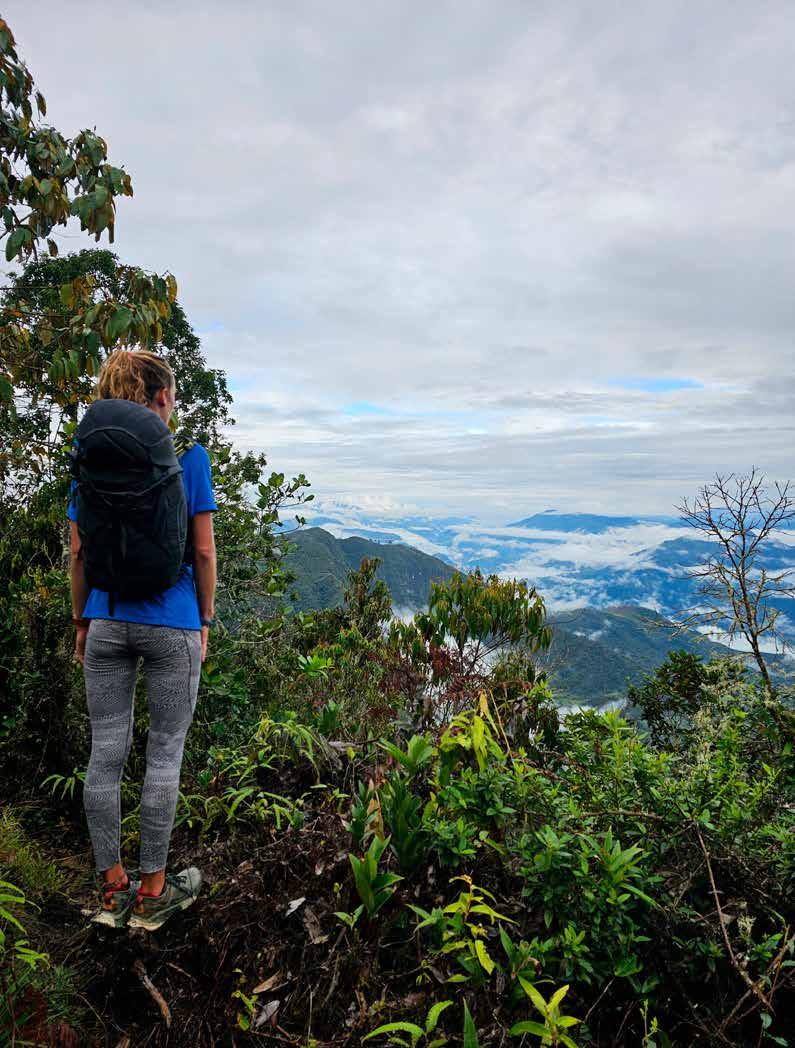
“There
is nothing quite like using one’s physical strength and experience flying to reach distant paradises and descend amongst the clouds.”
hours of challenging yet stunning trekking through the jungle, we arrived just as the sun was setting and enjoyed a breathtaking view from above the clouds. We collected water from the leaves of bromeliads for drinking and food preparation.
One of the defining characteristics of the páramo ecosystem is that the weather drastically changes within minutes. It can be sunny and blue one minute, then cloudy and windy the next. It rained throughout the night on San Nicolás and continued until 10:00 a.m. the following day. We were considering staying another night on top when the rain finally stopped and we felt a calmer wind cycle through. We immediately packed up camp and headed toward our planned launch. We decided to launch from just below the summit, as it was already late in the morning, and we knew that cycles would be too strong for a safe launch from the top.
I prepared my kit, consisting of AirDesign’s 14-meter UFO and Slip harness, on the lee side of the launch where I was protected from the stronger cycles. After patiently waiting for a launchable window, I was rewarded with one of the most beautiful flights of my life. I flew above the morning layer of clouds to where they
ended at the start of the valley. My glide was perfect. Soaring alongside dense jungle and majestic waterfalls, I felt incredibly alive.
Alex and I landed safely where we had parked the truck the previous morning, with huge grins spanning our wind-beaten faces. The family who lives on the farm where we parked greeted us with a delicious home-cooked Colombian lunch. They asked us a handful of questions regarding our journey, as they have lived at the base of the mountain for years but have never had the opportunity to reach its summit.
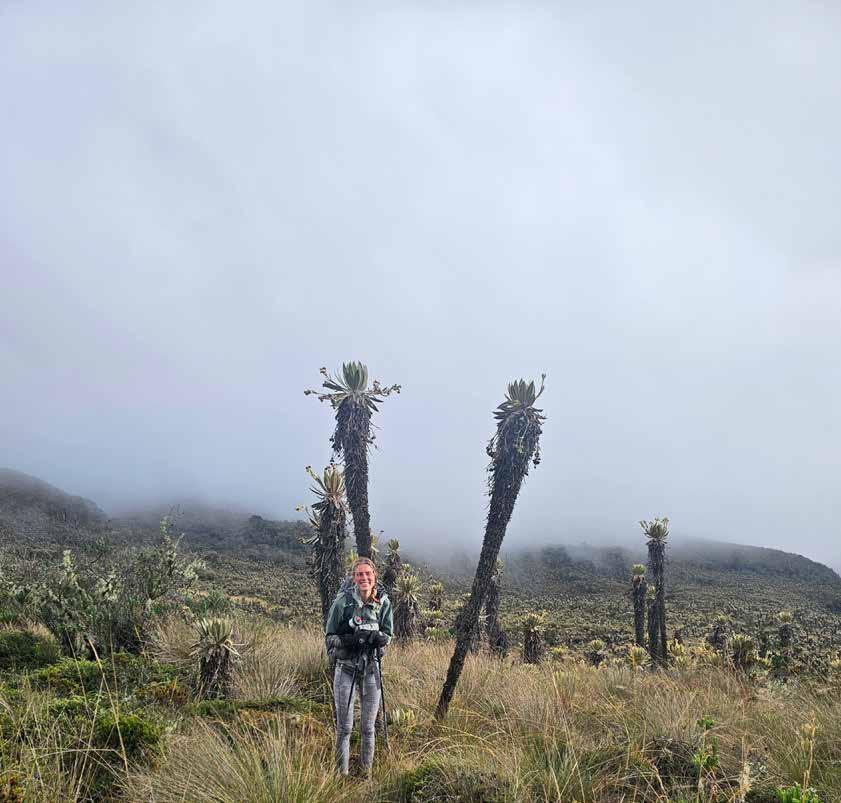
Before starting the road trip home, we shared coffee with one of the original mountain guides of Cerro San Nicolás. He had climbed the mountain about 100 times. He can no longer summit, as the descent is too hard on his back, but he smiled upon hearing of the possibility of descent using a lightweight tandem paraglider in the future!
About a month later, Alex and I hiked El Páramo del Sol, the highest mountain in Antioquia at 4,080 meters. This hike was less steep yet longer than the scramble up to Cerro San Nicolás. The 15 kilometer trail, which
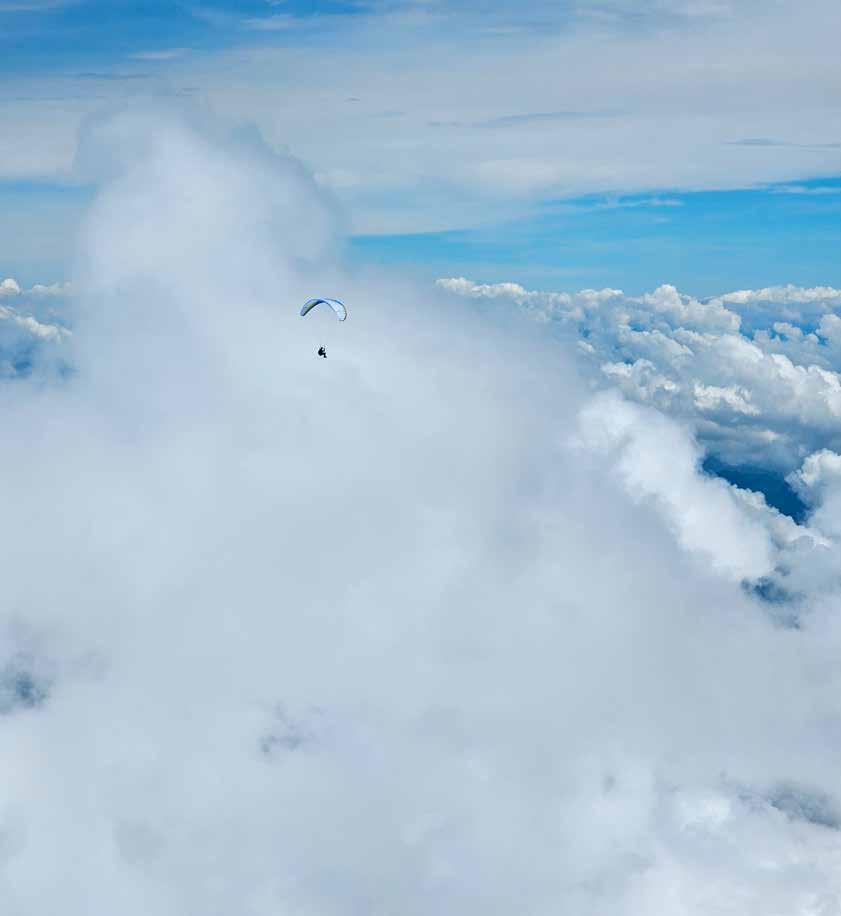
starts outside the town of Urrao, winds through the jungle and up to magical valleys full of Frailejones, some of which are over 100 years old.
We pitched the tent at the trailhead and slept for about four hours before hiking through the night. We decided to hike in the dark to avoid carrying camping gear to the top, planning to arrive at the summit at sunrise.
We started hiking around 11:00 p.m. and summited around 5:00 a.m., just before sunrise. Walking during the night is a different experience. There is nothing to look at except the small area lit by headlamp, and I entered a flow state previously unfamiliar to me. I relaxed into my thoughts and the movement of my body. The six-hour trek felt like three.
After we enjoyed the sunrise, the wind started to blow in nicely. We took advantage of the window and launched early. It had rained heavily during the previous days, and we decided not to risk waiting as we did not want to hike down. We found a patch on the windward side clear of Frailejones and prepared to launch. By around 7:00 a.m., we were airborne, experiencing the inexplicable sensation of flying after an intense physical effort. There was a thin cloud layer above the valley at an altitude that granted us plenty of time to
descend through the soft morning clouds and find a safe spot to land in the agricultural town of Urrao. We touched ground alongside a herd of curious cows, packed up, and celebrated over eggs, arepas, and coffee with the local friend who retrieved us. Giddy with adrenaline, we continued discussing the adventure throughout the drive home. We recounted to each other the thoughts that flowed through our minds while hiking in the dark, expressing how much we both enjoyed our first time trekking through the night. Finding a good partner for these big missions is essential, as the company makes or breaks the entire experience. Neither Alex nor I like to chat while hiking; we prefer the meditation that comes with being silent. We would rather listen to the wind, the birds, and the rustling of the leaves than talk for talking’s sake. We pull each other up mountains with our energy, and we know the silence will be broken when necessary.
The weeks between each big mission consisted of nonstop training, including trail running, strength training, and relatively small hike-and-fly routes. I live in the mountains above Medellin, just an hour-anda-half hike from a small launch at about 3,200 meters. On some mornings, we would train by hiking to the launch with lightweight kits and flying down to land
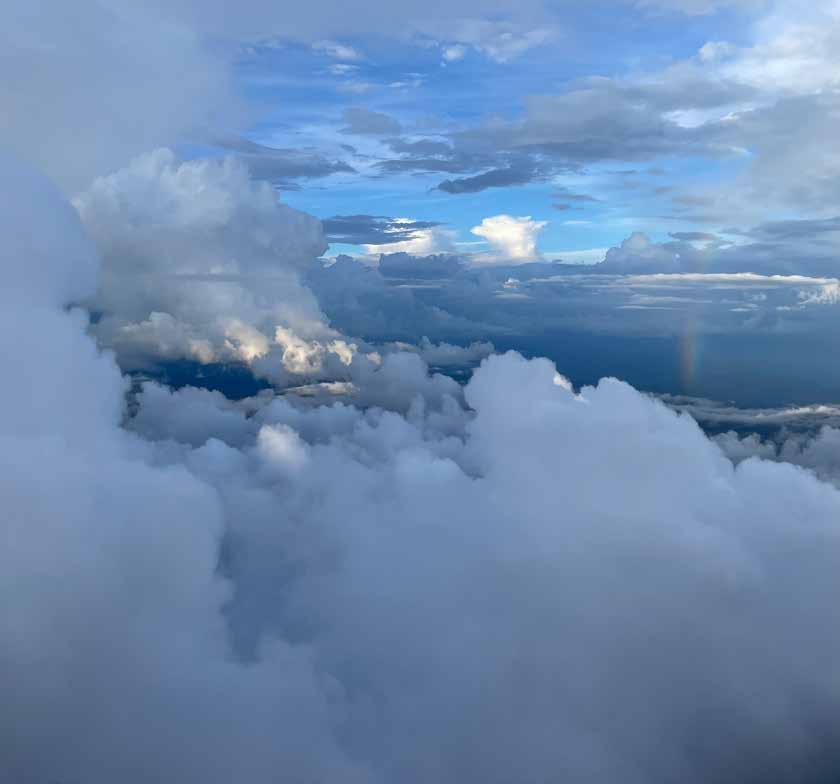
just below the house. The breakfast and coffee afterward never tasted so good!
After all the necessary training and preparation, the final mission of 2024 was the biggest, most challenging, and most inspiring. El Nevado del Tolima, a volcano in El Parque Nacional Natural Los Nevados, is among Colombia’s ten highest peaks, towering at 5,215 meters. The summit is a glacier composed of 69 million cubic meters of ice, a number that is rapidly decreasing due to the warming climate.
Our first day on the mountain involved 24 kilometers of hiking and 1,770 meters of ascent to the base camp of Arenales. Initially, we planned to sleep at a refuge at 4,000 meters, where there is a natural hot spring. However, due to our quick pace, we arrived at Los Termales del Cañon at 2:00 p.m. and decided to take advantage of the remaining daylight, continuing on higher.
The next morning, we broke camp at 2:00 a.m. and headed for the summit, carrying ropes, harnesses, ice axes, and crampons. The trek from base camp consisted of technical rocky sections and about one hour of hiking on the glacier. While hiking on the glacier, we were properly equipped with ice gear and connected with about 12 meters of rope between us, mitigating the risk of falling into a crevasse. On the way up, we
passed signs marking previous extents of the glacier, further dramatizing humans’ impact on this ecosystem.
We summited too fast for our own good, reaching the top at 5:00 a.m. It was still dark, and we were forced to wait about one and a half hours for the sun to rise and a launch window to open. We waited on top, constantly moving our bodies and walking in circles to fight off the bone-chilling cold. This was the most challenging part of the whole journey. My eyelashes were frozen and frost lined my pants and jacket.
The wind on the summit was not too strong, but the cycles were not consistently coming up from one direction. We carried our gear from one side of the glacier to the other, working to find the safest place to launch. Just as we thought we would have to hike down, the cycles began to consistently blow in from where we had initially planned to launch. Before every hike and fly mission, preparation includes studying maps and creating descent plans A, B, and C, as you never really know what conditions you will face. We had waypoints marked on our devices indicating safe places to land and offline maps downloaded on our watches and phones to ensure safe navigation.
I took advantage of the window, inflated my wing, and successfully launched, becoming the first woman to fly from El Nevado de Tolima. Launching from this altitude was distinct due to the thin air: I had to use
the entire length of the glacier for my feet to leave the ice and my muscles to relax into the harness. The whole way down, until my boots met the soft earth again, I gawked at the wild beauty of where I was.
Alex had to wait another 20 minutes for an adequate cycle but was soon able to follow me via paraglider. Once airborne, strong winds limited our reach, and we could only fly out about 6 kilometers. This left us with a 12-kilometer hike back to the trailhead. By the time we made it to the Jeep that would drive us to town, my legs were aching and my shoulders were numb, but my heart was full and my mind was clear.
These two days were some of the most physically demanding days of my life. From the high altitude to the distance to the 20-kilogram pack on my back, this adventure required every ounce of energy I had to give. It also provided me with another opportunity to meditate on the vastness of Mother Nature and observe her power. I am consistently motivated to embark on missions such as this due to my recognition of the importance of deeply connecting with the natural world. For me, it is intense meditation and is a connection only attainable in the places that are most difficult to access.
There is nothing quite like using one’s physical strength and experience flying to reach distant paradises and descend amongst the clouds. It is pure, liberating, and fueling. These missions would not have been possible had I not trained constantly during the time between. I continue to be amazed by all that my body is capable of. It inspires me to keep pushing and learning while I am still strong enough to do so.
: After this amazing season, I look forward to planning more hike-and-fly journeys in Colombia as there is still so much to explore. The Sierra Nevada de Santa Marta mountain range, located alongside Colombia’s Caribbean coast, holds the country’s highest peak, Pico Colon. This group of mountains is extremely sacred to the various Indigenous communities that rely on them, and possesses an energy that I will not even attempt to describe with words. Travelers must receive permission from the designated Indigenous groups
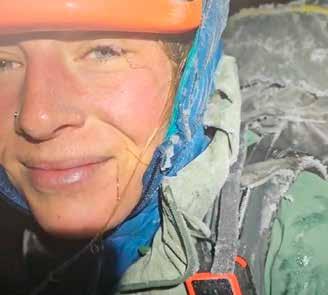

whose territory will be a part of any journey through these mountains, whether flying or not. I have only stared at them endlessly from the beach below. It is a goal of mine to be one of the first women to descend from their ice-capped peaks beneath the canopy of my paraglider.
These adventures would not have been possible without an immense respect for La Pachamama. The elements are strong and have a power that must be honored. Yet, we humans are a part of nature. There is a constant exchange of energy between us and our surroundings, which can be recognized with enough awareness. Every day, I thank La Pachamama for her protection and for allowing me to enjoy and learn from her entire force.
“The meaning of life is to find your gift. The purpose of life is to give it away.” – Pablo Picasso
: I have always enjoyed a good scheme—the more actionable version of a daydream. In the early days of my flying career, eager to solidify my footing in the paragliding community, I hatched a scheme to bring together the ladies of free flight to create connections and bring a little celebratory flair to the get-together. The inaugural Swifts Fly-In was hosted in Villa Grove, Colorado in 2019. Since then, I have hosted an additional four ladies’ fly-ins, and have twice hosted the largest free flight event in the country—the Red Rocks Fall Fly-In. Hosting all of these events has revealed to me that community bonding is a foundational skill we may not consider as necessary as kiting or forecasting, but we should. We pilots tend to pride ourselves on independence and self-reliance. After all, we are 100% responsible for our decisions when we fly. While that is all well and good, we bolster our longevity in the sport when we have a supportive community with whom to celebrate and commiserate. When I reflect on my happi-
est flying days, my friends are just as much a part of the memory as the sound of my vario.
If you have ever been to the Red Rocks Fall Fly-In, you’ll know the landing zone can be an electric and boisterous atmosphere full of pilots regaling each other with the highs and lows (both literally and figuratively) of their flights. I have met pilots simply by walking over to a recognizable wing and harness and high-fiving over a shared thermal. I do not know every pilot, but I know we all share a love of the sky, and there’s a special kinship between us all who do this wacky sport. Have you ever tried to relate the experience of circling at cloudbase to your coworkers at the water cooler or been met with bemused confusion at your explanation of how we don’t quite “jump” off the mountain? The chance to gather and share experiences and stories with our fellow pilots is a real gift. All this is to say that we all have a role in our community. I know that one of you is like me: You’re a schemer, a doer; you excel at tying a vision together and executing it. You want to fill a need within your local club for increased connection. You want to democratize our collective knowledge so that we all
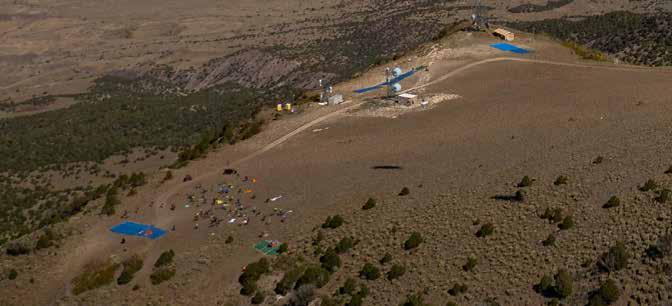
become better and safer pilots. If you are reading this and feel a call to give back but are overwhelmed with the “how,” read on.
The first thing to consider when throwing your event is the location. Are you familiar with the nuances of the local weather enough to confidently give weather briefings? If not, can you outsource this task to a knowledgeable local pilot?
Depending on the size of your event, does the landing zone have enough room to safely accommodate multiple pilots landing at once? What additional visual aids could be necessary (e.g., wind socks, streamers, etc.)? Is the launch large enough to accommodate at least a few pilots at a time? Is there a safe space for pilots to prepare for flight away from the main launch zone? Plan these zones before the event and give a proper site introduction to relate this information to pilots.
You will likely need to charge money to offset the cost of throwing the event. I have thrown small grassroots events out of my backyard and now have hosted the largest free flight event in the country multiple times. There is an endless possibility of things on which to spend money, but common expenses will be insurance, permit fees, high visibility vests, a microphone, t-shirts or other swag, food, trash service, porta-potties, and website fees. Optional expenses could include emergency service standby and compensation for your core team.
A small event, such as a weekend fly-in with a barbeque, T-shirts, insurance, and permits, can cost as little as $1,500. However, an event as large as the Red Rocks Fall Fly-In costs around $25,000.
Throwing an event is not a one-person job. I am guilty of taking on more than I should and burning myself out, and I highly recommend delegating to save your sanity. A small event can be handled with
an event coordinator, a safety coordinator, and a vehicle coordinator. In this scenario, imagine the event coordinator as the face of the event who coordinates with local agencies, applies for insurance, provides official communication to participants, collects fees and waivers, executes the daily schedule, and has the authority to close launch or call off flights for the day. The safety coordinator is responsible for keeping the launch safe and efficient, providing insight into the daily weather forecast, relaying pertinent information to the event coordinator, and communicating with emergency response personnel in the event of an incident. The driver coordinator organizes shuttle
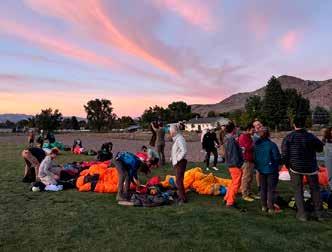
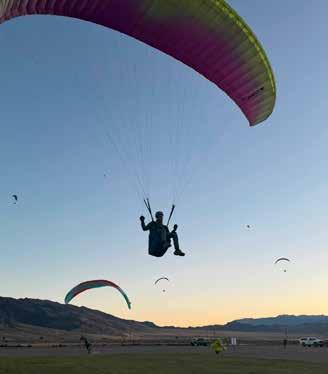
trips to launch, and coordinates retrieves if the event offers this service.
The larger the event, the more critical it is to have co-coordinators and a volunteer coordinator if your team of volunteers is large enough.
Volunteers are the lifeblood of a fly-in. They will point pilots in the right direction, help with registration, fluff wings on launch, move chairs, pick up food, unbox T-shirts, drive to launch, or drive retrieve. A good volunteer is worth their weight in gold, and you should set aside a portion of your budget to reward them. I like to ask mine for their favorite drinks and snacks to keep on hand. Make sure event participants know who your volunteers are and thank them daily.
Consider whether your location requires permits. For Red Rocks, we have a permit from the National Forest Service to conduct an event on their land. Don’t be discouraged if you face this hiccup—the paperwork can be easy. In our case, the Forest Service only requires a tally of total pilots per day during the event with an associated fee. In Monroe, the city owns our landing zone. We have an excellent relationship with the city, which simply needs timely notification of our event schedule. Please contact your local club officers to see what relationships exist with the landowners of your launch and landing zones. Using existing relationships when contacting government agencies or private landowners is best.
Speaking of local relationships, consider attending a city council meeting in the town where you plan to host an event. A face-to-face conversation is irreplaceable when explaining the nuances of a paragliding event. For Red Rocks, I attend three city council meetings a year—one to share the event schedule, describing each event and how it will affect the city; one just before the September season to solidify how we and the city will work together; and one after the events to report back on how it all went. By being upfront on every step, I can assure the town that we are working with their best interests in mind.
Some points of discussion at the meetings are messaging residents about keeping vehicles away from the landing zone, coordinating on dumpsters and traffic near the landing zone, placing extra streamers and windsocks, and creating a plan of action for emergencies. I call the sheriff’s office and contact the local head of Search and Rescue prior to the event to brief them on our activities.
In addition to the city council, consider contacting a local city or county tourism office member. Free flight lends itself to splashy content for these agencies, and you may be able to get some freebies through the relationships between your tourism office and local businesses.
Finally, consider including local businesses in your event. The coffee shop, the pastry store, the taco truck, and the pizza joint could all be
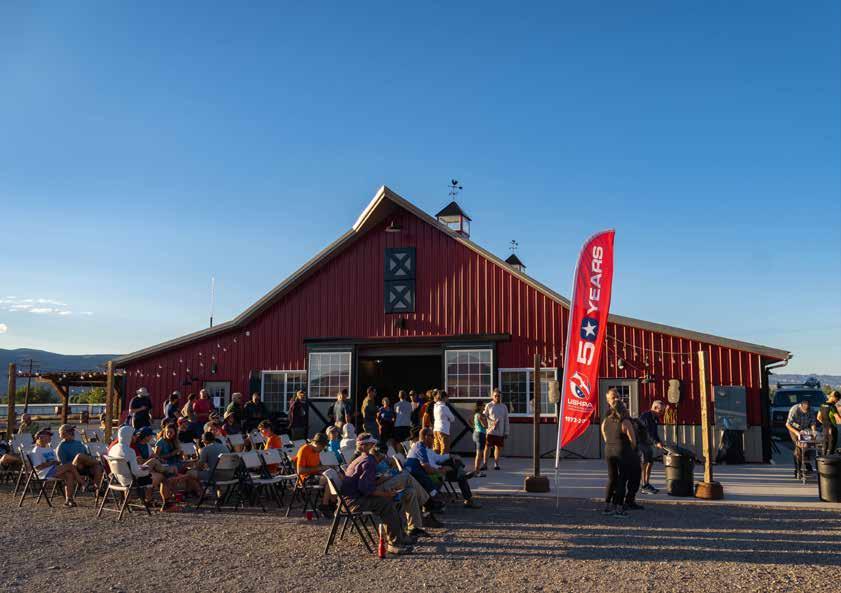


eager for a slice of the pie. Not only does this help the community feel involved, but it also helps spread the word about free flight to those who have not yet been exposed to the sport. Your goal is to create a positive association with free flight within the local community.
The Red Rocks Fall Fly-In supports local businesses by including chosen vendors in our coupon book, which each participant gets in their registration bag. The coupons are the result of a handshake deal with the owner of a restaurant to provide a free meal to a pilot at a subsidized price that CUASA will reimburse after the event. It is a great way to direct event participants’ money into the hands of local business owners. It cannot be understated how important these relationships are to the favorable viewing of pilots in the community.
Insurance
Love it or hate it, someone is likely going to require insurance to rubber stamp your event. You will also want peace of mind knowing that your personal




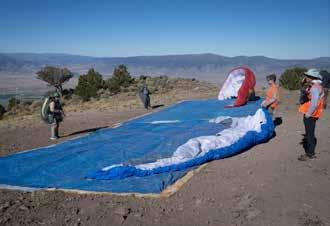
assets are protected in the event of an incident. If you are wondering if your event requires insurance, USHPA has a handy document on their “ACE Accreditation Application” page that spells out what requires insurance.
Insurance processing can take time. Submit your request at least three months before your event. The bright-line test that will likely require you to







have insurance is charging fees above the cost of general membership to your local chapter. For example, a chapter-sponsored barbeque after a normal day of flying is not going to require insurance. The Red Rocks Fall Fly-In charges an entry fee, so we must have insurance. Once you have determined that you need insurance, follow these steps:
1. Apply for Ace Accreditation on USHPA’s website. You need to provide the name of the event, a sponsorship letter from your local chapter, and some basic information like who the event coordinators will be, whether there will be instruction or towing involved, and whether you are seeking $500,000 or $1 million in insurance (some landowners require $1 million or more).
2. Receive your approved application for ACE Accreditation.
3. Receive your application for insurance with the Recreation Risk Retention Group (RRRG). To complete this application, you will need the coordinates of all launches and landing to be insured, the names of the private landowners or agencies of launch and landing zones, and a risk mitigation plan. The risk mitigation plan is a document that explains any risk during the event and your plan to mitigate it. For example, a general risk at the Red Rocks Fly-In is the remoteness of our terrain. We mitigate this risk by requiring a satellite communicator. You will also be asked how you plan to mitigate risk at any approved launch or landing zone. For example, Cove launch has power lines that run down the spine of the northwest aspect. This risk is mitigated by having the launch director point them out during a site briefing on launch.
4. Submit your insurance application with the attached risk mitigation plan via the RRRG portal and make corrections as necessary based on their comments.
5. Receive your approved application from RRRG, which includes Certificates of Insurance for each landowner and a waiver for your participants to sign. Participants at an RRRG-insured event must be active members of USHPA.
After determining your entry fees, clearly communicate to the public what the cost includes. Also, make it clear that participants must be current USHPA members and
members of your local club to participate. User-friendly websites like WordPress can help you build a page to advertise and collect applications or fees for your event. Reach out to your local club and see whether they are open to hosting your event on their website platform to utilize existing resources. I suggest establishing a cancellation and refund policy upfront, as it is common for pilots to contact you with requests for refunds due to life circumstances, injury, etc.
While I won’t tell you how to run your fly-in, I strongly suggest one piece of advice: Go into the event, repeat the mantra, “Flexibility is the best ability.” Things will go wrong. Your driver may cancel at the last minute, your club truck could break down, a volunteer may quit midweek, the weather could be unconducive to flying, and the show must go on. Just like in rock climbing, redundancy is the name of the game. Try to have extra drivers and volunteers to prepare for the inevitable day when something doesn’t go according to plan. Here in Monroe, we
deal with wild shifts in weather, so in the past, our backup plans have included speaker events, a tutorial on how to use XC Skies, a paragliding gear swap, reserve repacks, and ground handling practice in the landing zone. All that matters is that you try—we all know the weather is never a sure bet.
I quoted Picasso above because I love the idea that the purpose of each of our gifts is to share it. My gift happens to be logistics, and I am sure someone else out there has a similar gift to give to their community. If you are not one to throw an event, be an enthusiastic participant and realize that these events do not happen without your commitment. While we all like to chase good weather, planning an event where everyone signs up three days beforehand is impossible. If you want to see more fly-ins happen, commit to attending, hopefully flying, and definitely strengthening your bonds with fellow pilots. If this article inspired you, please feel free to contact me at lindseyripaburns@gmail.com. I would be happy to help answer questions to get your event off the ground.
Blue Skies!
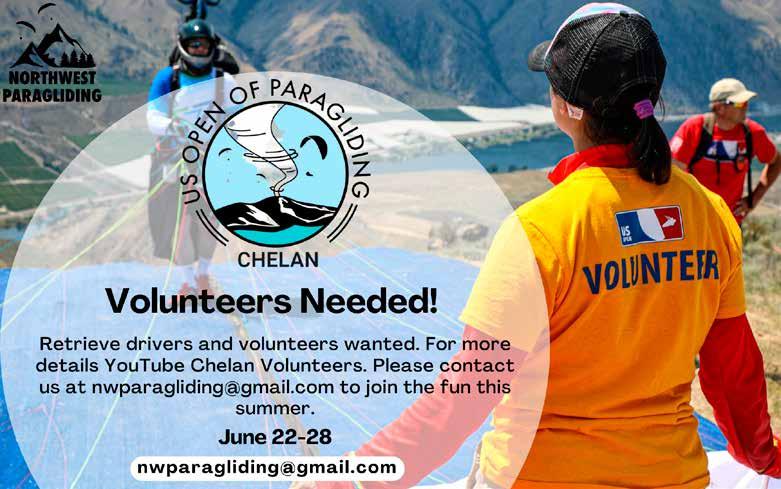
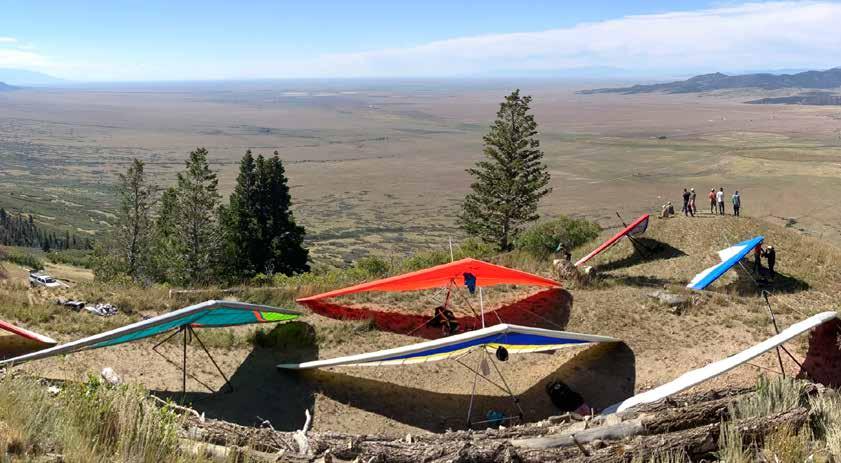
Jeff St. Aubin
: Labor Day marks the annual migration of Lookout Mountain pilots from Tennessee and North Georgia to Villa Grove, Colorado, seeking big air and stunning glass-offs. Oxygen systems are dusted off, long johns and ski suits are brought out of hibernation, and the rigs are piled high with all the camping gear and toys needed to live off the grid for a few weeks in the high desert.
Villa Grove is a spectacular site known to hang glider pilots nationwide. With stunning views all around, launch sits at 9,760 feet and faces southwest on the edge of a bowl below the 12,461-foot Galena Peak. The site is about a third of the way up the Sangre de Cristo Range. Several 14ers rise up to the south on the way toward Great Sand Dunes National Park, with the impressive Blanca Peak (the 4th highest mountain in Colorado) looming in the distance.
Getting up and out at Villa is not a gimme. If you’re not going up right off of launch, the move is to cross the gully to your left and work the triangular slope at the northern edge of Hayden Pass. If you strike out
there, it’s time to head out to the LZ by Larry’s and hope you have enough altitude to hook something popping off of the valley floor, which sits at 8,000 feet. This move seems to work reliably, but it can be pretty spooky scratching low over such a slanted alluvial plain. Turning on the upwind edge of a thermal allows for around 200 feet of clearance. But cranking around while hoping to not fall out the back side, the ground looms, and that clearance seems to disappear. With only cactus, sage, and rocks to judge your altitude, things can look deceiving. Sinking out before the reasonably flat field by Larry’s, you may find yourself in a never-ending ground effect, skimming over rocks and spiky vegetation as the ground drops away just enough to match your glide angle. At some point, you just have to commit, power flare, and hope you don’t get intimate with a cactus.
On my first flight at Villa, I launched a bit early and hit nary a bump but easily made it to the LZ on my Gecko. All good, mission accomplished; a safe launch and landing is all I ever ask for when flying a new site.
I radioed my friend Christina Williams, who was on launch with her paraglider, letting her know the air was still smooth. If she launched ASAP, she could probably get in another paragliding lap as it was still before 11:00 a.m. It was her first time flying out West, and I had been vocal about the dangers of the high-desert, big-mountain air, but as they say, we don’t know what we don’t know. As I finished breaking down, the longtime Aspen pilot I was chatting with casually said, “Oh look! They’re doing aerobatics!” I looked up, and my heart jumped to my throat. “That’s not on purpose!” I said and rushed to the radio.
Conditions on launch had changed after I landed: draw from strong thermals began to generate some tailwind cycles. Keen to get in a second flight and encouraged by my earlier report of smooth conditions and the advice of a local pilot who said it looked good (which it did for them), Christina waited for a cycle to blow in and launched. But now it was pushing 11:30 a.m., and the air was active. About 500 feet over the valley floor, she hit an absolute ripper of a thermal that threw her around like a rag doll. The glider went behind her, below her face, to the left, to the right, and back again. It was terrifying to watch, and it felt like it went on for far too long. I only had a few hours of paragliding experience and didn’t know what to say to her. Thankfully, someone wiser and calmer came on the radio and helped Christina make the right decisions. She managed to keep the wing open; by flying back towards the range, she escaped the brute of a thermal and was safely on the ground as quickly as she could descend. Back on terra firma, redlining on adrenaline, Christina was very thankful to be unscathed and appreciative of the free lesson. She was now more motivated to improve her skills and confidence in the air.
It is difficult to communicate just how powerful the air can be to the uninitiated. I love big air in big mountains—in my hang glider. Cranking into a 1,500+ fpm
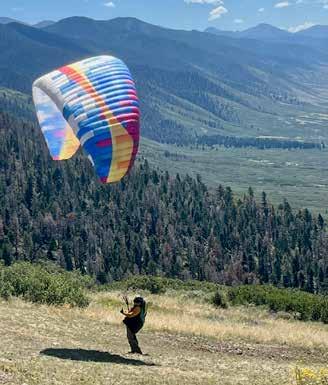
climb in my flexwing gets me giggling with glee, but the thought of encountering the tumbling edge of such a beast in my paraglider gives me cold sweats and weak knees. Kudos to the paraglider pilots who got off Villa early that day and made it down the range to the sand dunes and beyond. The pilots making peak-season big mountain flights in paragliders are Jedis. But also, have you considered hang gliding?
: The next day, I missed out on a dose of flying adventure as I had to drive back and forth to Denver to pick up my dad, Richard, whom I had recruited to come out for the week as a retrieve driver. For some reason, I usually feel more calm and collected flying XC with my dad driving retrieve; I probably feel more confident that I won’t make stupid decisions in front of him. This was his fourth time getting dragged across the continent to chase us sky addicts, so he knew the ropes. The forecast predicted it to blow east, so the plan was to fly the Whale. This 12,100-foot peak at the
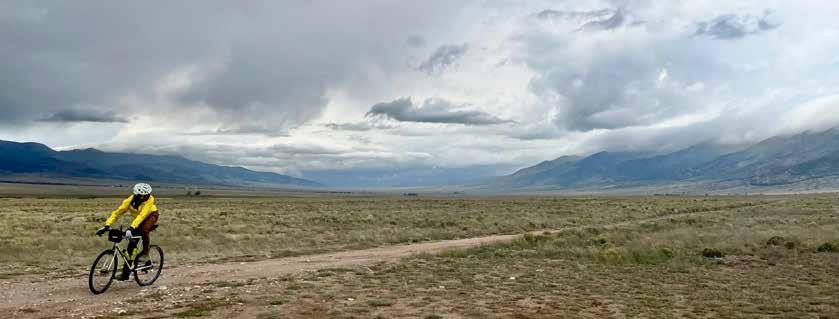
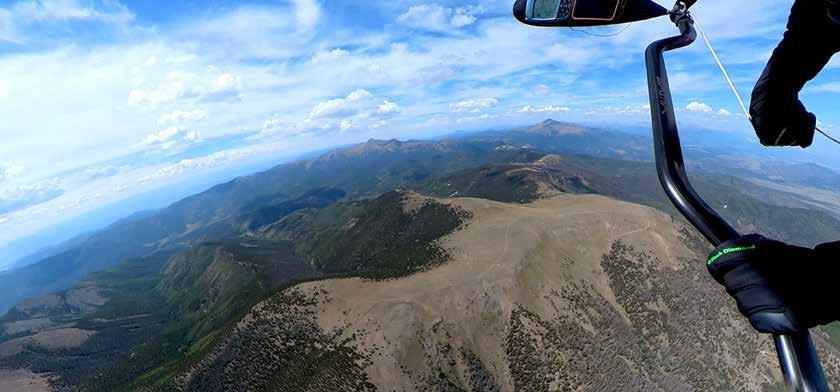
northwest end of the valley is accessed via a gnarly 4x4 approach. On our way back to Villa, I got a call that one of our group was missing. He had gone over the back, he was flying without an InReach, and no one had been able to reach him by phone. My heart sank; over the following hours, all I felt was anxiety and dread about the fate of my friend. Why didn’t he have an InReach? He was one of our group’s more accomplished XC pilots and should have known better. Luckily, there are only happy endings in this story.
Flying his paraglider down a cloud street past Bonanza, the pilot got pinned low and had to make an emergency landing in an avalanche chute. Bruised and battered but otherwise uninjured, he hiked down until he found a trail that led to a road. After another four or five miles of walking, he found a gate where, lo and behold, his girlfriend had just arrived, having followed his last reported location on XCTrack. As they rolled up to camp that evening, we were all ecstatic to see him in one piece, albeit quite humbled. Despite his misadventure, none of us would best his distance on this trip.
Many pilots climbed to over 17,000 feet that day and were able to fly back to camp. It proved to be the best flying day of the trip as well as one of the most dynamic. Even before our friend went missing, there had already been plenty of excitement. There was a blown
launch, a blown tire on the descent, and a couple of hard landings, one resulting in a decidedly U-shaped basetube. Thankfully, there were no more than bruised egos.
Our group learned some lessons on this day alone. You can get away with diving into the control frame when launching from Lookout’s very forgiving ramp, but this technique is slightly less desirable when launching on a flat slope above 12,000 feet. Additionally, be prepared to acquire some Rocky Mountain pinstripes on whatever 4x4 you bring. Seriously consider upgrading to properly knobby off-road tires if making the trip to Villa, as none of the approaches to
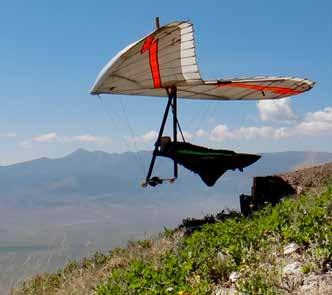
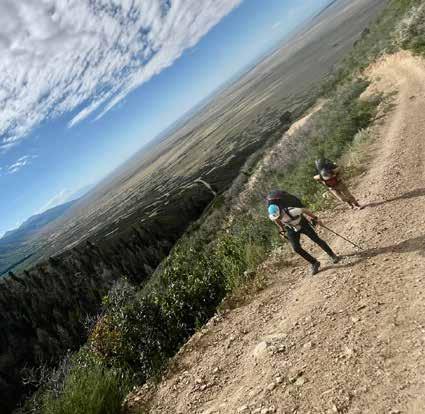
merino with oxygen flowing, hooked in, and ready to go. I am somewhat notorious for launching first, as I would rather sweat it out on launch with an empty sky in front of me, patiently waiting for signs that tell me to go, than wait in line to hustle off into a crowded arena already full of pilots vying for only so much lift. There are a healthy number of streamers crisscrossing the face below launch, so it is easy to map the thermals and their approach.
A nice cycle rolled through and I launched. We were warned not to turn 360s right off of launch, so I worked a few figure 8s to no avail and then hightailed
it across the gully to that primo southwest face at the edge of Hayden Pass. I connected with something weak and gained a meager hundred feet. Rego, another pilot on our trip, launched and tried to join the pitiful climb, but it fizzled out as we scratched up the shallow slope. We both pushed out toward the road to gain more clearance, and I connected with some more measly bubbles. I worked them as I watched Rego glide out toward the LZ. The climb never consolidated as I skimmed the terrain as far back as I felt comfortable. I pushed out toward the road once again when—BOOM—I hit it. Cranking and banking, I held on for three thousand feet and topped out the thermal at 12,000 feet nearly half an hour after launching. Still below the top of Galena Peak to my east, I decided to turn south and explore downrange.
After crossing Hayden Pass, it took a little bit of time to connect with another tight bullet ride. I bailed from the climb at 11,500 feet and kept pushing south, deciding to stick to the front range and just go for distance rather than trying to get back onto the upper ridge line. There was a light easterly forecast at altitude, and I figured things would only get more gnarly the higher I got. I headed south, and I eventually arrived above the bat caves (a pair of gaping voids in the orange rock) at 10,000 feet. I circled their openings, marveling at my vantage point above a few hikers, and eventually connected with another ride up to 11,500 feet. Pushing south another couple of spines, I found one more climb. By this time, my whole body was ach-
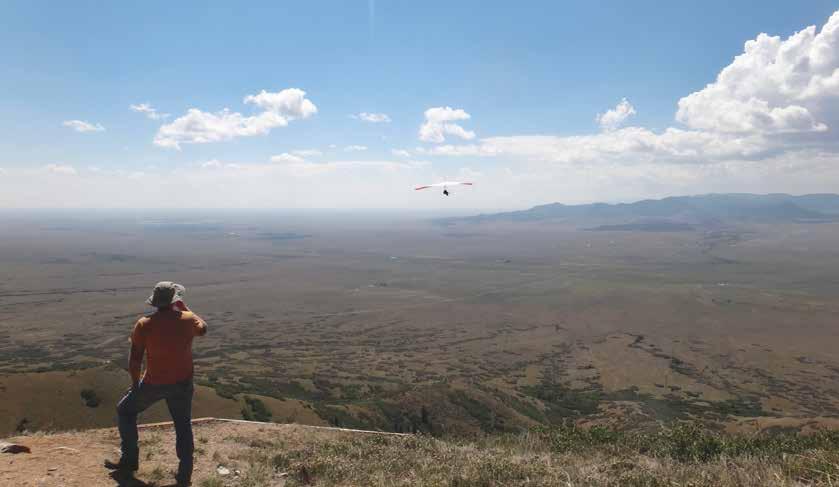
ing, and I was starting to feel the ground suck. I had noticed a nice landing spot relatively free of cactus back by the bat caves. Feeling rather jubilant after a smooth touchdown into the wind, I found I could barely lift my arms to unhook from my glider. My body was totally exhausted! I had only flown for an hour and a half and made it a mere 14 miles down the range, but it was one of the most rewarding and physically demanding flights I have had: every climb was a battle, and the best anyone else got that day was an extended sledder.
: The next few days offered meager soaring opportunities due to high winds or overdevelopment, but we made the most of it. Brian Morris stopped by on his way to Utah, keen to get in some high-altitude conditioning before participating in the X-Red Rocks. He convinced Christina and me to go with him on our first hike-and-fly mission. After her rodeo ride and my midday thrashing on the hang glider, neither of us wanted much to do with midday desert air on our paragliders. So we set off before the heat kicked in and tasted the morning’s first few bubbles. It was entirely satisfying and sold me on hike-and-fly as a complete experience without any need to have an extended flight. That evening, we made the trek out to Anne’s, a remote site halfway between Villa and Gunnison that, in the right conditions, can be a playground for ridge soaring, top landing, and hike-and-fly training. The site sits at just under 10,000 feet and offers only 700 feet of altitude to play with. We were a bit crestfallen to find that regional high clouds had shut down the forecasted wind, and we could only get a few paraglider sledders before sunset.
If you’ve ever booked a flying trip to almost anywhere but Valle de Bravo, then you know there are going to be days you can’t fly, so you’d better come prepared—and prepared we were! Christina, Doug, and Eric brought their dirt bikes and ripped around the surrounding area in every spare moment they had. Neil and I went
on epic gravel bicycle rides, braving venturi winds and dodging looming storm cells. The mornings offered hike-and-fly laps, and we squeezed in brief thermal flights before the skies darkened. Afternoon hot spring sojourns let us escape the fine desert dust that otherwise pervaded our existence.
Mark, Dalton, Parking Lot John, Rego, my dad, and Josiah all checked out the Great Sand Dunes National Park, Crestone’s spiritual tourism attractions, and even went on a gem-hunting trip. We all got a lot of entertainment heading into Salida to watch Eric surf the standing wave on the Arkansas River and catch some live music. After a week of high winds and overdevelopment, our numbers started to dwindle, but a few of us stuck around as we could see on the horizon the golden forecast we had all been waiting for: a blue, blown-out day with winds dropping into the low 20s towards sunset—the perfect forecast for a Villa glassoff!
Since I began flying, I have been regaled with tales of legendary Villa Grove glass-offs: flying straight into the valley and getting to above 16,000 feet without a turn, and 100-mile flights to the sand dunes and back as fast as your glider can go. While that Friday the 13th didn’t give us much more than 14,000 feet and no one made it to the sand dunes, cruising over the alpine lakes atop Bushnell Peak and soaring until sunset with my pals was pure bliss and made all the waiting worthwhile. The evening glass-off was my first big mountain flight on my T2C. I had waited to take it out as I was leery of landing my new-to-me topless hang glider at high altitude in switchy midday desert conditions. However, that one flight convinced me that a topless hang glider is truly the machine of choice for big mountain flying. The ability to easily cruise with 60+ mph airspeed makes 30 mph venturis a nonissue, and the amount of ground you can cover in such a machine is astounding. Floating across the valley over the highway in the buoyant golden hour conditions, I likely could have
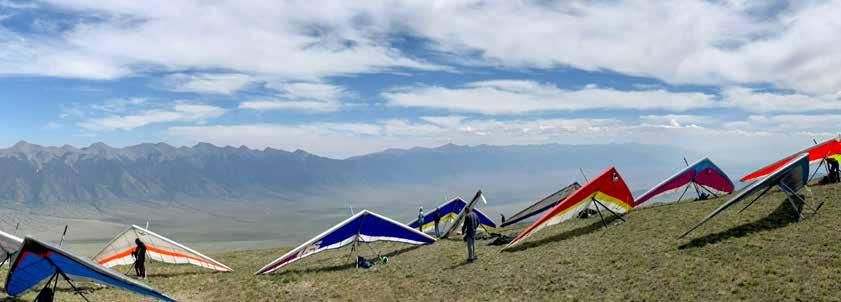
made it over to Whale, but I wanted to get down while the wind was still blowing on the ground for a smooth touchdown.
Over the week, we watched the aspens start to change color before our eyes. One morning, there was a single patch of yellow on a faraway slope. The following morning, two; and by noon that day, it had grown to three or four. Frost began to form on our tents each morning, and we knew it was only a matter of time before camping in the San Luis Valley became an exercise in frigid masochism. Thankfully, the skies delivered us a final day of puffy cumulus, light winds, and the opportunity to soar the Sangre de Cristo Range to our heart’s content, cruising thousands of feet above the peaks. Once you broke 13,000 feet that day, things went nuclear.
Twirling on a wing tip—“churning the butter,” as they say—my vario was pegged, making sounds you never hear east of the Mississippi. Grateful to be back on my Gecko, which at this point seemed an intuitive exten sion of myself, I let the turbulence buck me about as I carved around, seeking out the rocketing core with the
stupidest grin on my face. Few things in life compare to such sensations. In such booming mountain conditions, I sincerely believe a hang glider is the best tool for the job. Seeing quadruple-digit climb rates only had me drooling for more.
Villa Grove is the real deal. Sure, just surviving in the San Luis Valley day after day is a challenge, but watching the sun light up the valley in the morning, and the stars gleam into existence each evening makes the searing heat, frosty nights, howling winds, and constant dust worth it. If you decide to venture into the heart of the Colorado Rockies, come prepared and bring your A-game, as peak season high-desert conditions are no joke. Every launch and landing at altitude requires skill and confidence to avoid a face full of cacti. When you’re trying to squeeze in flights between pockets of overdevelopment, you need to keep your eye on the sky and be aware of how conditions are changing. Most importantly, though, bring some good friends, your


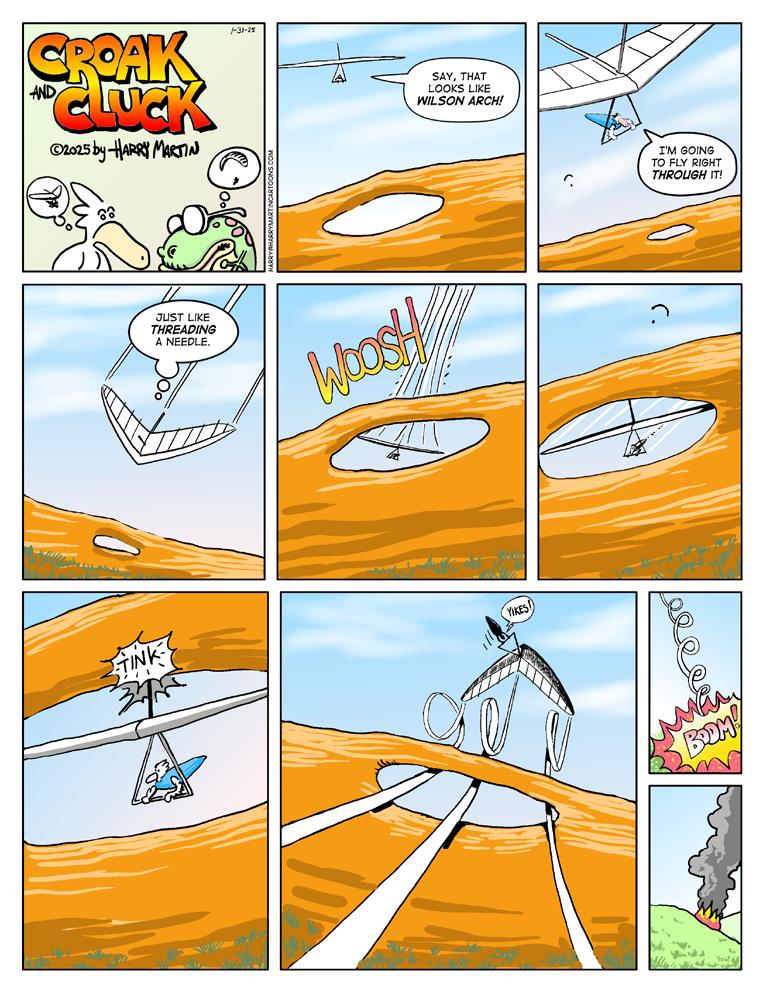
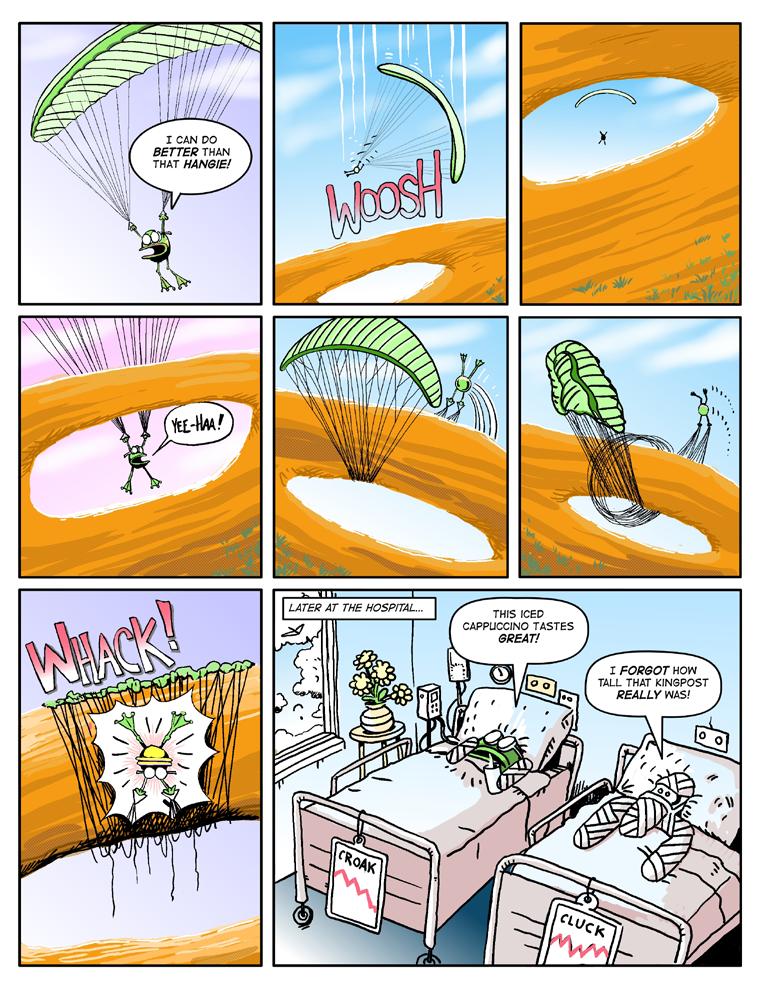
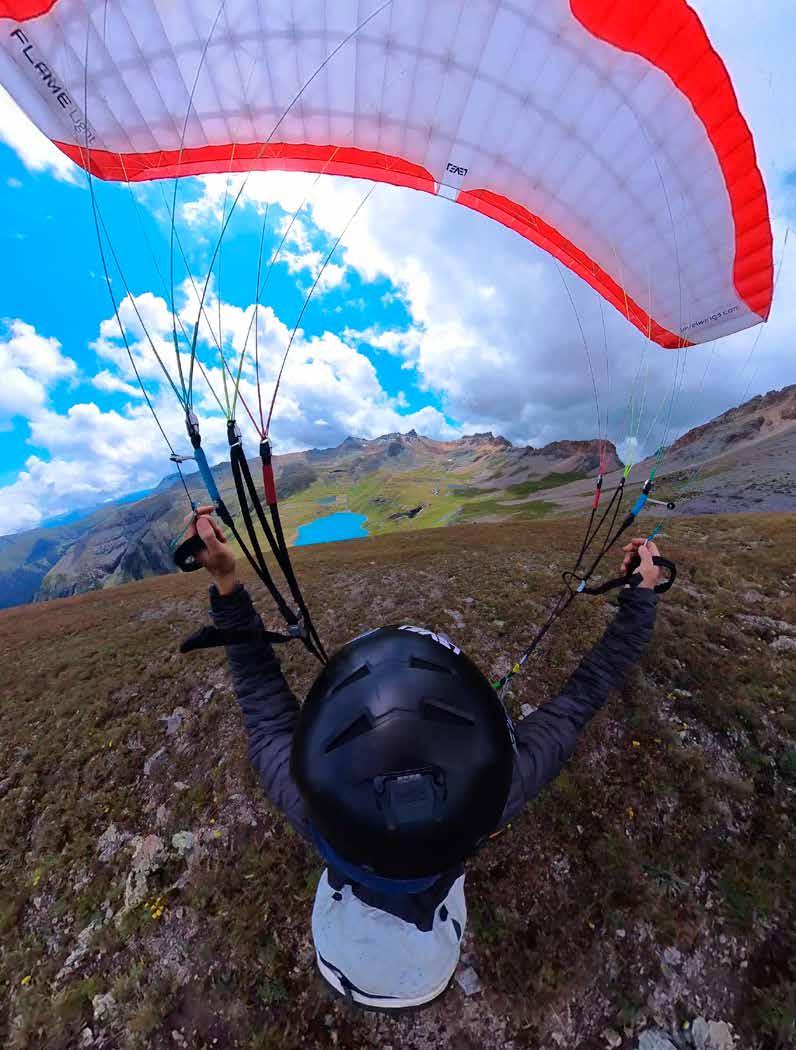
: Years ago, I saw photos on a friend’s Instagram of a beautiful Colorado high alpine lake that was glacial blue and another with clear waters featuring shades of blue and green, with an island in the middle, surrounded by high peaks. It was one of the most stunning locations I had ever seen. It inspired me, and I knew I had to visit. But life gets busy, and I mostly forgot about it.
Fast forward a decade, and I was reminded that I wanted to see Ice Lake and this beautiful area when I decided to make the trek from Utah to New Mexico for a friend’s wedding; it would only be a short detour into the zone! Now, as a pilot, I had dreams of flying this spot as well, with the specific goal of flying over the lake and foot-dragging the deep blue water at 12,000 feet. What a dream landing area!
I started to look at logistics: Could it be done? You can fly off any mountain assuming you have light enough winds, a good place to set up and launch your wing, and a suitable landing area. After a deep dive into Google Earth and FatMaps (RIP), I found that the area had the correct launch and landing requirements. I plugged that location data into XC Skies and took a moderately in-depth look at the forecasts. Unfortunately, it didn’t look good for the first half of the trip—high winds paired with low pressure/instability and thunderstorms made the area unflyable.
However, there seemed to be a consensus that the winds would significantly lighten up on my way back, with winds projected to be from the SSW at about 8 mph at 12,000 feet and 13 mph at 14,000 feet. I located a potential launch area from a 13,000-foot peak directly over Ice Lake, facing south. The grassy shoreline landing zones also seemed possible. It was finally time to head up to Ice Lake basin to escape the city and get some much-needed nature.
Because this location was so beautiful, I didn’t necessarily need to fly there; I just wanted to see it in person. This was no easy feat, considering it was
Launching with the gorgeous Ice Lake below.
an 8.3-mile round trip hike with about 2,800 feet of elevation gain just to reach the lake/landing area.
However, I was bringing a very lightweight kit: a Level Wings Flame 9m light wing and a Kortel Krueyer 3 lightweight harness, which I mainly use for speedriding missions due to its low pack volume.
If the flying didn’t work out, I had backup plans in place that included a lot of other gear (an FPV drone for cinematic flying, a wetsuit, an ultralight tent, and backpacking gear). Plus, one cow-spotted wiener dog named Zetsu and my girlfriend Ariel, who has been flying paragliders for a few years now.
Based on prior experience, I knew flying deep in a mountain range as dynamic as the San Juans is tricky. As beautiful as the mountains are, they are equally complex, especially how wind and thermals mix to create unstable conditions. You really need to be on your A-game with forecasting in these environments, especially if you’re pursuing flight.
On the evening of August 25, we drove into the San Juans via Highway 550 on the tail end of a massive thunderstorm. We pulled over and waited for it to continue tracking northbound. Once it passed, the views opened up to reveal high, snow-capped mountain peaks as we drove toward the Ice Lake trailhead. The sun was setting, and we were euphoric about the surrounding landscapes. It felt like being in the Alps! The setting sun painted the gorgeous peaks outside Silverton in alpenglow, igniting our imagination. As paragliding and speedflying pilots, we look for flying lines everywhere, and rediscovering this range inspired creativity and energy about what’s possible in this world.
We ended up at the Ice Lake trailhead in the pitch black, and a storm developed, bringing more precipitation. We got some sleep and started hiking the next morning around 6:30 a.m. Once again, post-storm, the clouds broke apart, and we made our way up past creeks and waterfalls, quickly climbing in elevation. We were already above 10,000 feet, and the landscape was epic.
About 1,000 feet below the Ice Lake basin, we reached a clear creek rushing with enough power that we spent more than 10 minutes looking for a safe crossing. I’m usually quick to find a way to navigate tricky creek crossings, but this one was particularly challenging. Eventually, we found one segment that looked possible. I assisted Zetsu across, then Ariel.
When we topped out at the basin, we were greeted with the most beautiful high alpine lake I have ever seen. It glowed beneath the broken clouds, sections of sunlight revealing a bright blue color with hints of emerald, absolutely confirming that our effort was worth it. We set up camp on the north side of the lake, which was the best-looking option for a landing area. This spot would be amazing to fly over. Unfortunately, it was not the primary beach/grass landing zone I had scoped out on Google Earth. The other one was less of a glide, and the terrain was a bit more uneven, but it would still make for a suitable bailout landing zone if needed.
After setting up camp, I quickly configured my small hike-and-fly pack and set off for the south-facing peak towering above Ice Lake. It was clear from the start that I would need a good glide ratio to make the landing area; I needed to glide over the blue Ice Lake itself to reach the shoreline. As I took the ridgeline up, I quickly broke the 13,000-foot mark, and the air felt thin. It was later in the morning than I had wanted, and the only thing keeping the thermals at bay
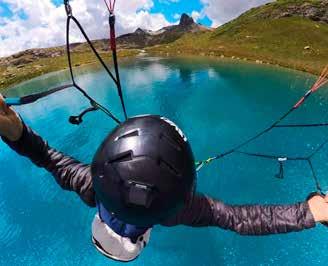
Coming in over Ice Lake with speed.
was some high clouds around the 15,000-foot mark lazily drifting overhead and shading out the terrain. The launch area I had scouted out on Google Earth ended up being very manageable: a huge zone to set up multiple wings, with a mix of grass and scree. Coming from the Wasatch Front, I was used to this environment. I pinged Ariel on the radio to get a reading on winds in the landing zone; she reported them as light but variable. We could also see some thermals moving across the lake from the south side and a slight wind shadow on the west side of the basin.
I set up on launch and kitted the 9m Flame into the upslope wind. It was stronger than expected, a quick reminder that I was in a dynamic high alpine environment above 13,000 feet. I thought about the clouds and thermals and waited for the conditions to shade out.
Eventually, the headwind was almost dead on, and as the shade returned, I pinged Ariel on the radio, informing her that I felt confident about the conditions and was likely to launch in the next couple of minutes. With a pressurized wing overhead, I ran to build speed and flew off the peak.
On glide, I was amazed by the environment around me—the deep blues of Ice Lake reflecting vibrant colors, the contrast between the cloudscape above, the upper peaks with snow, and the beautiful lake basin below. The glide lasted a long time, but staying focused, I dropped my trimmers to increase speed,
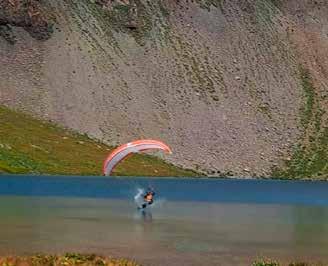
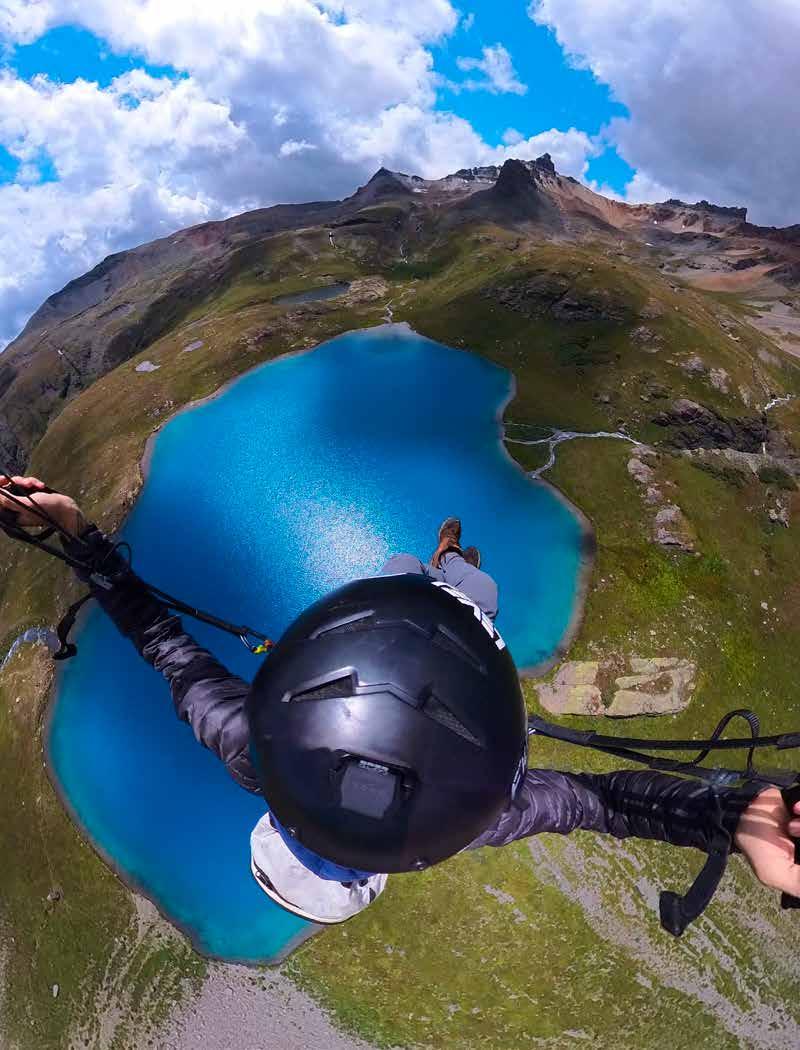
planning to glide above the water and foot-drag the surface for style points (of course). Landing at 12,000 feet, I knew I would be coming in quite fast, and my stall point would also be faster than usual.
I started skimming the water, getting my toes in there to create the spray effect I had envisioned! It was going perfectly until I got a little too deep in the toes, which caused a loss of airspeed, and I stalled the right side of my wing. It happened fast, and I wasn’t getting those style points anymore. I ended up doing a bit of a PLF (parachute landing fall)/water skip across the lake and landed in about two feet of water, pretty close to my intended landing target. It would have been an accurate spot landing if I hadn’t created so much foot drag for the water effect.
Wet and cold, I dried off and happily passed the next few hours until early evening, when there could be a second opportunity to try again. The day went by quickly, as there was always something to do. I hiked into new areas with creek systems and waterfalls and flew the FPV cinematic setup to capture the
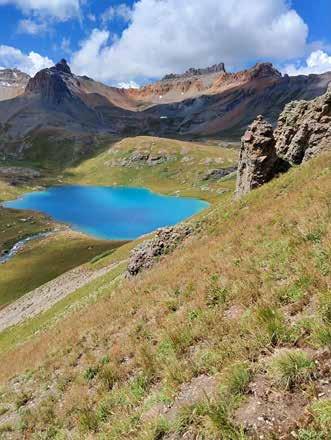
beautiful views.
At around 6 p.m., the thermals and winds started to lighten. I knew it would be my last chance for quite some time to get in another session from that same mountain launch and another shot at swooping over Ice Lake’s emerald blue waters, which felt magnetic. I decided to switch things up and hike directly up the “line” to launch, which was extremely steep and a fun climb to reach an alternate launch just west of that morning’s first lap.
After some kiting and feeling out the conditions, I deemed it safe to fly again, as the winds were very reasonable and still straight in. I pinged Ariel on the radio to let her know I was launching and took a hard run down the steep slope to build speed. It was an easy transition into flight, and I was gliding over the serene landscape once again. I wondered if anyone else had ever flown this location, especially down to Ice Lake basin.
The air was more consistent, and the glide was more enjoyable than the first lap. I wasn’t trying to be a hero, and I executed a couple of predictable 90-degree turns with my trims open to build speed. I set up at what felt like a barely acceptable distance back from the grass landing zone (being deep over the lake) and brought the wing in with some speed. The 9m flew fast, and I had more energy built up this time. As I got low over the water, I pushed myself forward in the harness to stand up and try to drag just the smallest amount of my shoe to create that water spray effect.
Unfortunately, I pulled just a bit too much on the rear risers and ended up flying about a foot above the water—a real tragedy for style points, but it ended with a perfect landing. I glided fast and far, landing right next to camp on the grass landing zone.
Landing at a high alpine lake surrounded by the beautiful San Juan mountains and a glacial blue lake was an absolute dream. Missions like this drive me to keep exploring, flying, and getting more creative with my locations. The problem-solving aspect, as well as the challenge of the mission, provides a high-value experience.
Thanks for following along on the adventure, and remember to respect your own journey and progression.


by Brian Petersen *Written with support from Erika Klein and Heather Harston
: On windy days on the South Side at the Point of the Mountain, Utah, we can spot an unprepared visiting pilot within 30 seconds of when they set up. Typically, their harness shoulder straps are a bit too tight so their seatboard is too high, and their stance is too straight-legged. The typical out-of-towner thing to do is to pull too much on the A’s, so the pilot gets plucked four feet off the ground. Then they don’t brake check, so the wing shoots out in front, lands upwind of them, blows back, and gift-wraps them. In a way, it’s a good thing because they likely won’t try it again in that much wind until they’ve practiced in calmer conditions. However, if they can’t manage their paraglider, they might give up on the sport.
Don’t let this be you. Below, I describe the most common windy kiting mistakes I’ve seen pilots make during 18 years of teaching at the Point and around the world, and suggest what to do instead. I also share a few exercises I teach my students in order to kite comfortably in winds up to 16 to 18 mph.
Poor setup location: Choosing an area full of roots or other hazards is a common mistake. It’s not unusual to unpack out of the way of launching pilots, but unpacking in a debris-filled area can result in tension knots or picking up sticks. Recommendation: Unpack your wing where you want to inflate it. If you unpack your wing in a debris-filled area and then rosette it, there is a good chance of snagging your lines on tough weeds or collecting hitchhikers. Your wing won’t be as clean as it would be right out of your concertina bag. Lay out your wing in a place that’s clear of weeds and upwind obstacles so you can inflate it from there.
Building a wall: It’s common to build a wall, but pilots often mess up their glider when they set it back down. Sticks on the ground can grab and tan-
gle the lines. Even on grass, the glider doesn’t always set down cleanly. Recommendation: Use your hands to open your wing and fan it out as much as is appropriate, depending on the amount of wind. Grab the leading edge near the center cells and pull each side outward to open the wing into a fan shape. Open less of the wing in high winds and more in lighter conditions. Keep the trailing edge low to the ground to prevent it from catching the wind. Check the wingtips for lineovers.
Not keeping tension on the lines: If you’ve gathered all your lines and are about to drop them on the ground and walk backward—stop. You depend on these strings, and you’re unnecessarily abusing them every time you kite or launch this way. Recommendation: As you walk backward, release one loop of your lines at a time while keeping a little tension on your wing. This keeps your lines off the ground, gives you an opportunity to clear tangles, and maintains a small amount of tension, which will help keep the wind from blowing your glider around.
Rapid inflation: Pilots often pull too hard and too quickly on the A’s, then don’t release them quickly enough. Recommendation: Pull up slowly. Practice pulling only as much as you need to on the A’s to bring the glider overhead without overshooting. A slow inflation in strong winds will pull you horizontally; that’s OK. Stay low and run or slide downwind with the wing, keeping constant tension through the risers and lines to bleed off that energy in a controlled manner.
Standing up straight: Many pilots inflate their wings from a straight stance, which can lead to getting plucked. Recommendation: Stay low. This is my number one thing to focus on when kiting. Bend your knees and tilt your body forward to get your butt into the seat of your harness (loosening
your shoulder straps to make your seat board lower will help with this). Keep your knees bent as you inflate (and while you kite) to load the harness and your glider with your body weight. Keep your turn direction foot behind you (so if you turn left, your left foot should be back). The low stance may feel tiring initially, but keep working on it.
Reducing lift with A’s and C’s: Pilots often use this technique in wind to keep from creating lift when pulling the brakes. If you pull the A’s too much, you’ll need to brake your wing, which can lead you to think you need the C’s. The problem is that pulling the C’s removes pressure from the airfoil while disconnecting the wing from your body. Ideally, you’re flying the paraglider from your hips, but grabbing a handful of C’s disconnects the wing from your hips, so that’s a negative. Recommendation: This one is controversial, but if you’re gentle on the controls, you usually don’t need the A’s and C’s. It’s about learning how to kite properly, which I cover below. I recommend only using the C’s to bring the wing down in strong wind or possibly on a steep, gusty launch.
Reverse kiting with too much brake: Pilots often make a brake input and then hold it with a stiff arm. Another common problem is for pilots to pull one brake but not let their other hand come up at the same time, so they’re too heavy on the wrong brake. Recommendation: Keep your hands moving and
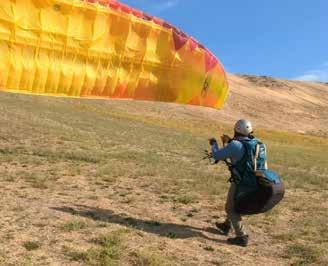
tuning the wing. If you pull the brake on one side, let the other hand up off of the wrong brake. Stay in front of the glider’s movements with bodywork to minimize your use of the brakes.
Looking at the wing: Looking up at your glider disconnects you from your bodywork and can make it hard to keep your hips level. This can cause unintended inputs to the wing. Recommendation: Look at the glider as it comes up and glance at it occasionally. If the wing is good, it’s good. If nothing’s changing, don’t look at it.
Bodywork refers to all inputs and movements aside from pulling on the toggles. Bodywork mainly refers to inputs through the hips but also includes foot placement, bent knees, smooth steps, posture, shoulder position, keeping eyes up, etc.
Standing up straight. Maintaining a semi-squat can be physically demanding, so pilots often don’t. However, not doing so leaves them no margin to move upward with the wing when needed, so they get plucked and dropped. If they don’t maintain line pressure on the drop, they will trigger a frontal collapse, resulting in the wing dragging them across the field. Recommendation: Keep your knees bent, tilt your body forward, and get your butt into the seat of your harness. This stance will allow you to move up or down to maintain constant tension in
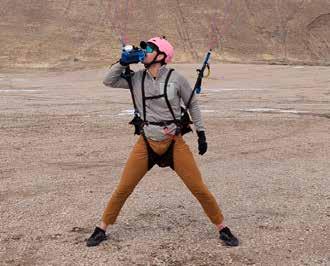
the lines with your body weight and to feel changes in the wing in time to catch collapses.
Fumbling with a deflated wing: New or visiting pilots often run toward the side of their grounded glider to depower it. It usually works. Recommendation: Once the wing has been deflated and is on the ground in a wall configuration, reach up and grab a coil of C’s and brakes so that they are shorter than the other lines. Be sure to keep a small amount of tension on the A lines! If the wind is extremely powerful, you can grab a coil of B’s as well. From here, you’re in a controlled stance and can slowly walk toward the wing as you coil your lines, keeping some tension on all lines and keeping the C’s and brakes coiled shorter than the others. Approach your glider and stuff it into a stuff sack, or pack it into a tight bundle so the leading edge can’t re-inflate while you walk.
Uneven bodywork when forward kiting: Pilots often don’t keep their hips level. Uneven hips give inputs to the glider. Pilots may also sometimes walk
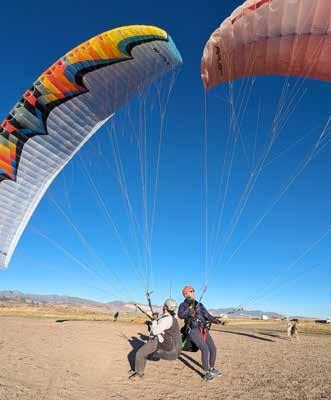
too quickly, making the wing surge and bounce; so they have to control it with a brake input, which

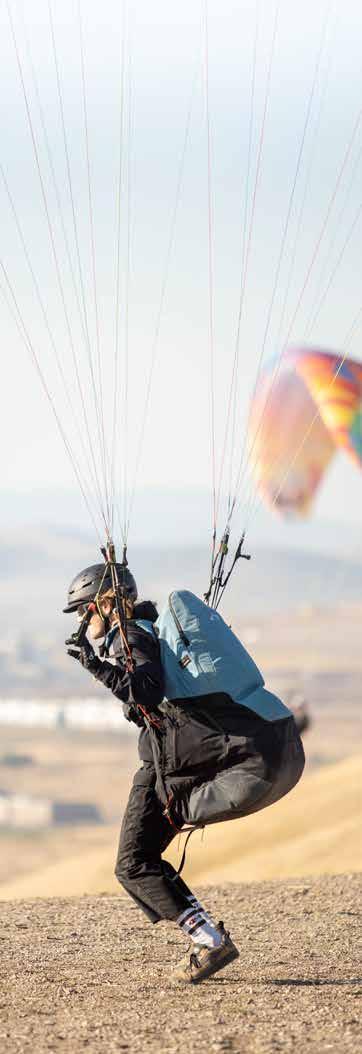
Pilot Max Schoenlein waiting his turn to join the traffic while getting conditioned with everyone's wake turbulence. Photo
by Jackson Chou
we’ve already established you want to minimize in strong winds. Recommendation: Keep your bodywork smooth. If you can walk smoothly and accelerate the wing uniformly, you won’t need the brakes. What gets you out flying in strong wind is being smooth with your bodywork.
Trying to catch yourself with your brake in your hand if you fall over: Most of the time, when people fall over, they put their hand down to try and get themselves back up. If they’re still holding the toggle in their hand when they do so, they’ll pull way too much brake and may get dragged 50 feet sideways. Recommendation: Let go of the low-side brake before putting your hand on the ground. You may need your hand to help you get back up, but you still have to fly the wing, too.
Poor body posture during transition. The moment you stand up straight, your butt’s not in the harness anymore. Then, if you launch, you’ll be hanging by your leg straps. Recommendation: Like when kiting, keep a low stance. Bend your knees and slide your butt up into the harness before or during your launch run. Then, lean back into your harness after you take off. This lets you focus immediately and fully on flying, rather than messing with a stirrup or pushing on risers to scootch into the harness.
Over-braking. Whether reverse kiting, forward kiting, or launching, pilots often pull too much brake. If their hands aren’t precisely balancing the wing, they can get into pilot-induced oscillation (PIO). Recommendation: Pull less brake. You should have a touch of brake pressure for launching, unlike with kiting where we’re going for no or minimal brakes. But even for launching, it should be just the tiniest touch for some connection to the wing. Looking at the ground. It’s common for concentrating pilots to look down while focusing on the feel of their wing or while relaxing their neck muscles. Recommendation: Eyes up! Look where you’re going. Remember to always check traffic before launching.
I use the following exercises in my kiting clinics with new students and current pilots working on their windy kiting skills (check our website at peak-paragliding.com to sign up). Start in winds of around 8 to 12 mph in a big, open field with no obstacles. Wear all safety equipment (helmet, back protection, gloves, etc.).
Learn to anchor with a low stance and to properly use the A’s.
1. Clip in reverse with your hips square to the wing and your turn direction foot behind you.
2. Bend your knees, lean forward to get your butt in your harness, and hold one set of center A-lines in each of your open, upward-facing palms with your hands extended toward the wing. (Leave brake toggles on the risers.) Open hands are important—lift upward only. Grabbing lines and pulling toward you is too much in stronger wind.
3. Lift up on the A’s to inflate the wing (like building a wall) and hover the wing one to three feet above the ground. Keep a low, heavy stance to anchor yourself in place. If the wing pulls you forward, resist it until you can’t anymore; then, let yourself slide or walk toward the wing while keeping your low stance and line pressure constant. Practice knowing when to lift or release the A’s so the glider doesn’t come up higher or fall to the ground.
4. Most wings want to come all the way up. If this happens, release the A’s and use two fingers on each hand to contact your brake lines (not toggles) with your palms facing away from you. You want to be connected with them before you need to pull on them.
5. Practice until you feel comfortable hovering the wing just above the ground for about a minute.
Practice using bodywork instead of brakes to control your wing. Keep your butt in your harness by keeping your knees bent and body tilted slightly forward.
1. Hover your wing above the ground for about 30 seconds (see WING HOVER exercise). Then, slowly and in control, bring the wing up overhead, releasing the A’s to make contact with the brake lines (not brake toggles).
2. Keeping your stance low, push back into the wind, using bodywork to keep the wing overhead. If the wing falls to one side, turn your body toward the low side to bring the wing back up. You can’t really overdo your bodywork like you can a brake input—twist your hips as much as you need to. Kite for a few minutes using bodywork and brake lines. The quicker you are with body and feet, the gentler you can be with the brake inputs.
3. If that's easy, grab the brake toggles with the correct hands and reverse kite for a few minutes on the toggles.
4. If that's easy, turn around and forward kite. If you take a deflation or lose control, be ready to quickly turn back to reverse. You’ll have better control when reverse kiting—the controls are easier to find. Letting go of the lines or toggles can sometimes save you when it’s windy because you’ll no longer be deflecting the trailing edge with the brakes and powering the wing.
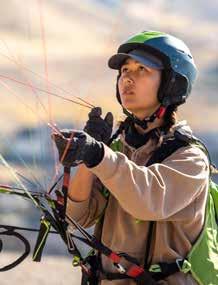
Develop your pitch control, sensitivity to the energy in the wing, and brake control.
1. Forward kite with the wing level overhead, pointing straight into the wind. Sink into your torpedo stance, keeping your hips low with your butt in your harness.
2. Smoothly accelerate into the wind, keeping your hands high behind you as you run forward. If you’re holding a little brake, you won’t build enough speed or energy for the exercise.
3. Once you have enough speed, add brakes as needed to create lift. As you start to go up, transition from torpedo position to sitting upright in your harness. Keep your brakes at the same level throughout this step.
4. When you’re at the top of the climb and about to descend, add a little more brake to slow your descent.
5. As you touch the ground, go hands up, get low, and walk forward to stay ahead of the wing and avoid a frontal.
6. Repeat this exercise until you can do it smoothly in medium to high winds.
: Ozone recently released the latest ultralight evolution of the Rapido series, the R3X. It is an evolution of the Rapido 3 with increased roll sensitivity, reduced weight, and more precise riser controls for a more dynamic feel while flying. The shortened lineset and wider piloting stance serve well for speedriding and speedflying for pilots seeking a capable wing for both summer and winter flying. Using lightweight fabrics, unsheathed lines, and thin risers with soft shackles, Ozone’s design team reduced the glider’s weight to a feathery 1.82 grams in its 11-meter version. The R3X’s small pack size makes it easy to run laps and enables faster, longer, and bigger mountain missions. On days when flying is not in the cards, the light weight makes it easy for the pilot to make safer decisions, as hiking down with a lighter backpack is always appealing. “This wing was a true collaboration between
top-level speed pilots and Ozone’s renowned design team,” said product manager Carl Weiseth. “We underwent many iterations and significant refinement to create a multifaceted all-season glider tailored to advanced pilots.”
The wing’s ultralight design and reduced sail weight inertia are appreciated on the uphill and also facilitate significantly easier and shorter launches. Widened pulley attachments create a comfortable position on launch, especially when running and launching over technical terrain. The R3X also features an innovative new pulley-riser design for enhanced control when piloting on the B/C riser bridge.
“This wing unlocks a whole new level of speedflying,” said project contributor and team pilot Jeff Katz. “It has allowed me to get deeper into lines and manipulate the risers in an entirely new way for

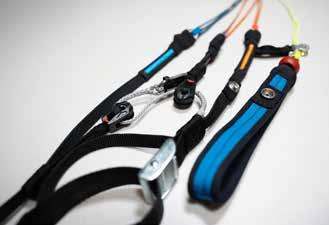
increased precision.”
The R3X’s ability to foot-launch in light or nil winds has made it popular with many pilots pioneering big mountain descents. However, its shortened line set and minimal sail inertia have also broadened the Rapido range into winter speedriding by enabling the glider to mirror aggressive ski turns. The addition of ball-grabs to the redesigned toggles allows for comfortable piloting in winter gloves, and the lightweight fabric and lines rapidly dry out after contact with moisture.
“When designing this wing, we wanted to
The thin risers showcasing an innovative new pulley-riser design for enhanced control when piloting on the B/C riser bridge.
make it as versatile as possible,” said Weiseth. “We aimed to create one wing that would perform at a high level in any season and any situation. The R3X truly feels like a pinnacle achievement in the pursuit of those goals.”
My personal journey on the Ozone Rapido series began with the 15m in 2022. Slowly, over several years and hundreds of flights, I progressed to the 13m and then the 11m. I believed the Rapido 3 was the only wing I would ever need to meet my speedflying criteria until I encountered the R3X.
From my first demo flight onwards, it was immediately apparent that I would need to upgrade. The overall size and weight of the wing made my hikeand-fly adventures substantially more efficient. I was shocked when I first picked up the glider: I thought I had been given the wrong size. When packing for my longest mountain missions, I can fit
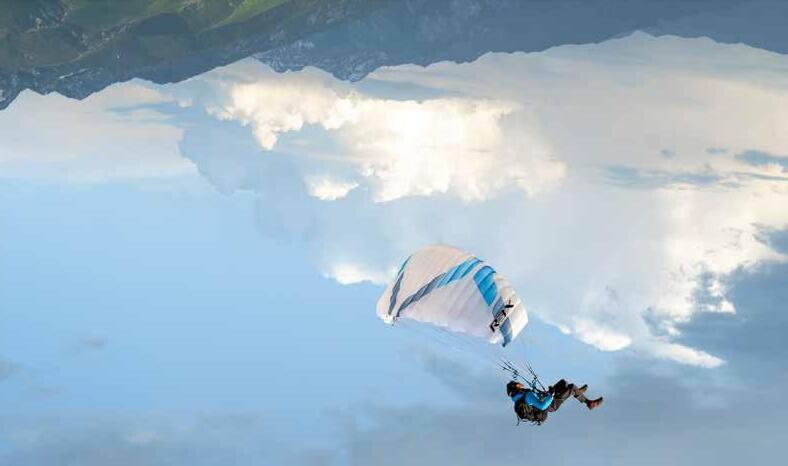
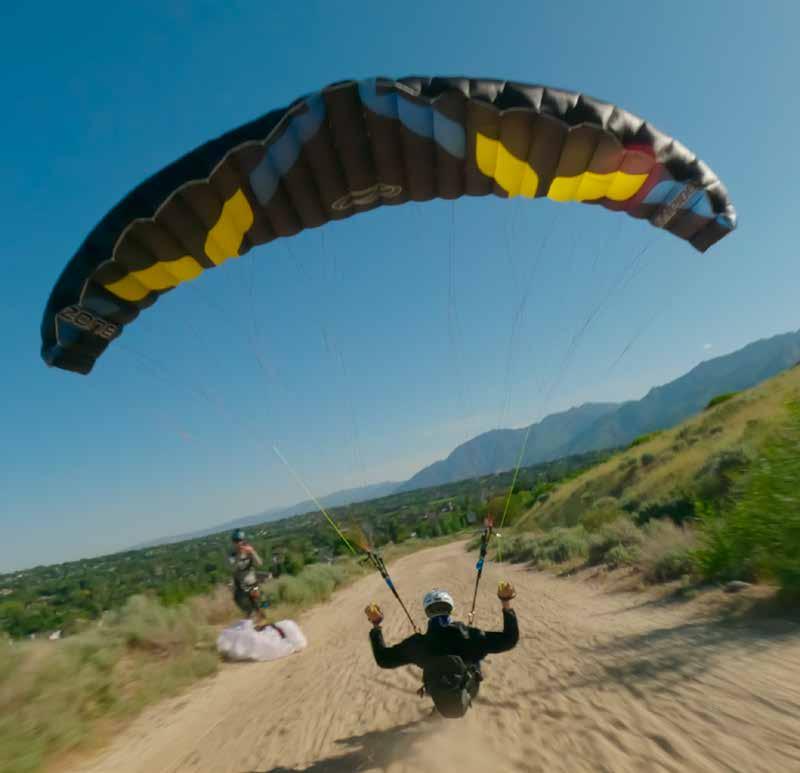
my R3X 11m, Ozone Ozo, helmet, layers, and water into an 8-liter running vest. In flight, this wing is much more dynamic than its predecessors. It has a more intuitive, connected response to weight shift, and it executes barrel rolls seamlessly with a snappy and dynamic sense of flight. The redesigned B/C bridge took me a few flights to get used to but rapidly became my favorite
feature—allowing frictionless trim manipulation from a trims-out orientation.
Not only is this now my wing of choice for foot launching, but I also love this wing for speedriding. It launches very easily in little to no wind, and the additional trim range allows me to stay more connected to the ground. From speedriding in the Wasatch backcountry to the ski slopes in France,
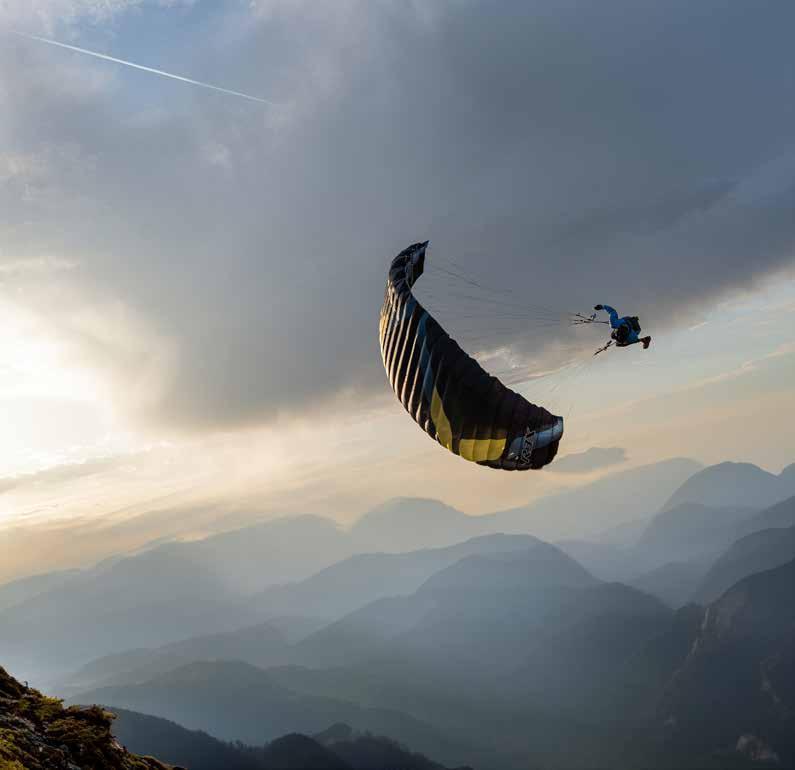
this wing is a strong choice.
The bottom line is the new Rapido 3X is an uncompromising speedwing created for advanced-level pilots seeking high performance and low pack weight. This is a versatile glider with increased roll sensitivity, reduced weight, and more precise riser controls. The significantly shorter line length and wider piloting stance serve both speedriders and
foot-launch pilots seeking a more advanced wing for flying year-round.
“No matter where I am or what line I am flying, I am always confident with an R3X in my pack,” said Weiseth.
To learn more about this new and revolutionary wing, contact your local dealer or visit Speedfly.com for additional information.
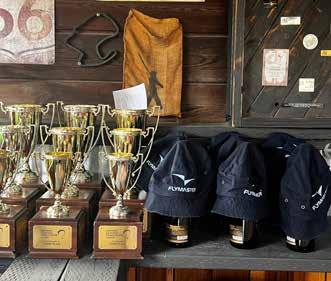
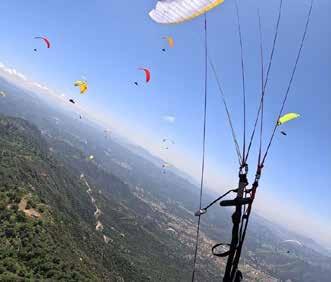
by Jugdeep Aggarwal
: In addition to another year of memorable events in the Northern California Cross Country and Sprint Leagues, there were some critical changes.
First, to accommodate increasing insurance costs, we implemented a membership fee for those coming to the league (apart from first-timers). This fee helped pay for the sites where insurance was required (Dunlap and Tollhouse). The second change was an increase in dues to pay for the increase in insurance costs.
Another big change for the XC league was to have two potential sites established for each weekend, making the call on the Wednesday before as to which site would be used. Though this increased the amount of planning required, it did result in higher participation for the XC league since we were able to target the site with the best cross-country flying.
Task distances increased significantly for 2024 to attract more experienced pilots to the league. However, just three percent of the tracklogs submitted were from EN-D pilots, indicating that either fewer EN-D pilots are participating or that these pilots want even more challenging tasks to entice them.
Additionally, we modified a rule to allow CCC gliders to participate. However, for whatever reason, there were no CCCs flown in the league for the 2024 season.
For those unfamiliar with the league, we hold raceto-goal events one weekend a month from March to October. We fly at sites local to the Bay Area and promote this as a “fly-in with a mission” rather than emphasizing the race-to-goal aspect. This mentality is meant to encourage non-racing pilots to attend along with those who want to fly with friends, knowing that there is a retrieve at the end of the day.
There were some definite highlights from the 2024 cross-country league. One was on a 100 km task set out of Slide near Lake Tahoe. Of the 16 pilots that came out for the day, 11 made goal, with most pilots climbing to over 15,000 feet. During an early season task out of Dunlap, we set goal at Eckert 76 km away. The task ended with only two pilots in goal, including first-timer Valentin Petters on a Swift 6. It was also great to run a task in the Owens Valley; for many, this was their first experience flying there. We set a modest task of 50 km, but the launch conditions were exceptionally challenging. Muuo Wambua won the day. The numbers for the XC league stacked up with 152 tracklogs submitted for nine tasks by 43 different participants.
In the Sprint league, it is always great to see so many junior pilots trying their hand at cross-country flying
Cat 1 XC (EN-D and below)
1st Doug DeGeorge
2nd Jugdeep Aggarwal
3rd Doug Anawalt
Cat 2 XC (EN-C and below)
1st Doug DeGeorge
2nd Jugdeep Aggarwal
3rd Doug Anawalt
by tackling more modest tasks. The Sprint league features fishbowl-style tasks to keep logistics simple since there is no dedicated retrieve system. It uses classic Bay Area sites such as Tollhouse, Dunlap, and Potato Hill. Throughout the season, we had 148 tracklogs from 40 participants flying eight tasks (see results above).
Congratulations to the winners and those who made it for the first time. Congratulations to those who went out of their comfort zone and went a little further, higher, and longer than before. Well done, all. I look forward to seeing you all next season.
Testimonial from Zach Koppe
I cannot believe we run off mountains. Forty-seven minutes until the task started, and I was on launch, ready to go. It was a beautiful 40 km task on the west side of the Sierra mountains at Dunlap. The task had us tag local favorites like Bald and Tucker Mountain before transitioning to the flats and racing north toward goal. League organizer Jugdeep Aggarwal always suggests that pilots get off launch earlier to feel out the air, and I’ve slowly learned to love this pre-race time. I relaxed and settled into my sky hammock, taking it all in while I enjoyed the views, the birds, and flying with my friends; it was all surreal. With less than a minute until the start time, the gaggle inched closer to the edge of the start cylinder, and the next thing I knew, we were off. I cannot believe we run off mountains.
Testimonial from Jake Rendina
I met Jug on June 12, 2005, at Tollhouse, California. I was looking for a site orientation, and he and the participants of his XC league were looking for help getting up to launch. Within a couple of years, I became a regular participant and remain one to this day. I was initially attracted to the community of expert pilot participants (many of whom became my unofficial mentors and, ultimately, close friends) and the pros-
Cat 3 Sprint (EN-B and below)
1st Alex Honda
2nd Evgenii Sirotin
3rd Ghalhang Rai
pect of developing the skills to fly XC in amazing places. These days, I make goal more often than not, and I never regret any humbling experience of landing early. Many new participants assume that the XC league is going to be some testosterone fest of pushing each other into risky situations. I’ve found that this is not the group culture. Most participants quickly adopt the attitude that the task of the day is just an opportunity to practice thermalling, gaggling, and making good decisions to either stay up along the course or land safely in sometimes very weird places. I’m grateful for the XC league—if it weren’t for the community and challenges offered by the league, I likely would have drifted away from this sport years ago.
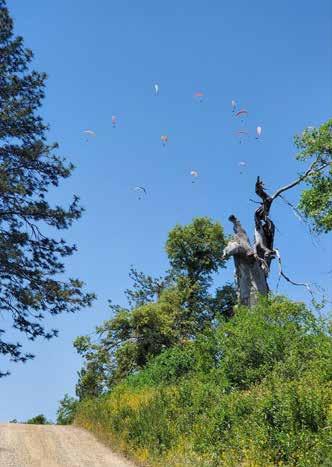
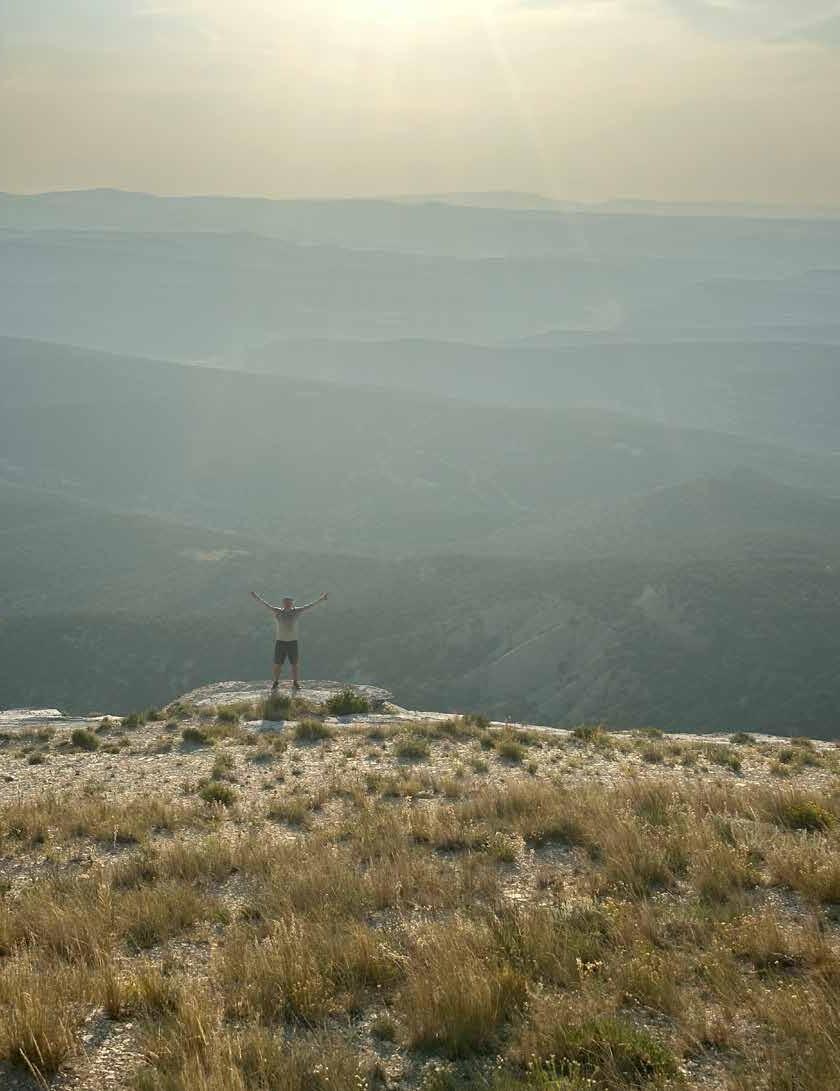
: Three strikes, and you’re out. But what if you push it to four? In early August of 2024, I found out.
On the day of my accident, our little group consisted of just myself, my son Ryan, and a friend interested in learning more about paragliding who served as our shuttle driver.
My son and I have been flying paragliders for six years, with advanced ratings and flights at many different sites throughout the western U.S. and Mexico, including this one four months prior when snow was still scattered on the ground. The launch is on a beautiful high plateau, 2,200 feet over the valley below, with a cliff band ranging from 10–500 feet tall along the upper face. Views are expansive in all directions, full of canyons, trees, and mountains. As a nice bonus, the LZ, 2,200 feet below, is accessible
with approaches from all directions. It was a beautiful late afternoon in the high desert of western Colorado with moderate winds, soft, friendly clouds, and no storms in the forecast. We hoped to enjoy some gentle sunset ridge soaring before pushing out on a glorious glide down to the LZ.
However, this was a desert landscape in the middle of summer. Temperatures in the truck on the shuttle drive showed 100–102 degrees Fahrenheit, and there was no relief from the heat on the hike up to launch. Though the shuttle allowed us to utilize a 4x4 trail to cut off some vertical (about 1,200 feet), our route was straight up a spine of deep scree and sand with loose footing the entire way. The heat, combined with the extreme slope and conditions, zapped our energy. The amount of work to make
“I had a pain in my chest that felt like I had been hit by a train. I couldn’t breathe; I couldn’t think; I was completely enveloped with pain.”
the summit made the idea of hiking down very unappealing. This was Strike #1 in the cascade of events that led to my accident: physical exhaustion/ dehydration and a preformed mental block against walking away from the flight.
Once we made the summit, our attitudes improved with the beauty of the site. The positive evening forecast combined with memories of the amazing flight I experienced before slowly re-invigorated our stoke. Despite the sweat-soaked slog up through the scree, I was buzzing with excitement when I reached launch. The views were expansive, stretching for miles in three directions, full of the rich tapestry that is the interface of mountains and desert. Earlier, we had placed a large, three-mile visibility windsock in the LZ that confirmed wind speed and direction were great at the bottom. Excited anticipation continued to grow as we unpacked our wings.
We reviewed conditions on launch, and the base wind, though perfect strength with a soft gust differential, was not in the ideal direction. This range of bluffs runs north to south, with fingers and spines reaching toward the west, creating bowls along the way. The ideal launch direction is directly into straight west wind. On this evening, however, there was a significant north component that was not showing up on the forecast or the windsock in the LZ.
Ryan, from his certified flight instructor (CFI) mindset, didn’t love it and questioned our options. We set up our wings, inflated, and kited for a bit to feel the conditions; indeed, the wind was 90 degrees cross relative to the main cliff face. However, where we had hiked up was on the spine of a shallow bowl, and I convinced myself that with a slight trajectory adjustment, I could launch 45 degrees to the main face with my wing 45 degrees to the meteorological wind direction. This was Strike #2 in the cascade of
On launch overlooking the valley.
decisions that resulted in my accident. Crosswinds over 45 degrees are never recommended. Modifying my launch trajectory to try and game the 90-degree crosswind reality was a foolish flight plan fueled with some classic free flight “hope-ium.”
: As I prepared for launch, my son’s questioning of conditions was present in the back of my mind. But while kiting my wing, the meteorological wind support was solid. I told myself that if I generated enough ground speed, I would easily fly away from the hill, even with the crosswind. However, I failed to verbalize or even process my launch abort criteria—I was in full send mode—Strike #3 in the cascade.
The last malfunction in the day was a deviation from my routine pre-flight check. Normally, after I put on my lightweight jacket and gloves, I retrieve my Garmin InReach satellite tracker from my left pocket and … Wait, where is my InReach? I’d left it in my other jacket in the truck—Strike #4. However, after checking my phone, I realized I had three bars of service. I figured I could let a couple of buddies know where we were and what the plan was, and when I got to the LZ, I would send an LOK (landed o.k.) from my InReach.
My wing came up easily overhead, solid and smooth, allowing for a complete line inspection with good pressure in the harness. In my dehydrated and compromised mental state, further deluded by excited visions of sunset soaring this cliff face, I turned, lowered my shoulders, and ran toward the cliff. I ran hard to generate the airspeed necessary to create the lift to float me off the ground and into that surreal sunset.
And here was where the inner voice of self-awareness finally found some space … We are not flying! Why are we not flying? This is taking too long! At which point, two things happened simultaneously. I had the thought: I should abort, and at the same
time the wing accelerated, and I felt the familiar joy of liftoff. Sadly, my self-awareness voice didn’t have the backup of my self-regulation muscle to abort this flight attempt.
The meteorological north wind I was quartering into gusted just as I came off the ground and my wing was pushed to the left. I blasted my left leg, riser, and wing straight through the top of a dead skeleton pine tree that was poking up just over the lip of the cliff. The top of the tree harpooned through the wing’s left tip, stopping all forward momentum and whipping me into the cliff face. As I impacted the cliff, the tree top broke, and I fell 30 feet to a three-foot-wide mid-cliff ledge. Landing on my back, all I remember is a flash of overwhelming pain and then being ejected into open space.
I was seeing flashes, and my mind registered: sky ... dirt … clouds … desert. For some reason, I balled up as small and compact as possible and cannonballed straight into a scree field at the base of the cliff. If I thought the pain of the first impact was overwhelming, the pain from the next was all-encompassing. The second half of the fall was from 45 feet. The pain was a full-body explosion that crushed my entire being. I heard wrenching screams that faded to the deepest of moaning, and I slowly realized these groans and moans were spilling out of me.
: I had a pain in my chest that felt like I had been hit by a train. I couldn’t breathe; I couldn’t think; I was completely enveloped with pain. But if you’re crying, you aren’t dying, so just breathe. In a flash, the next thought … Where is Ryan? Thankfully, he had paused to watch my launch instead of launching simultaneously. When he saw me blast the dead tree, he brought down his wing and started the rescue. As a paramedic and firefighter of 28 years, I knew the likelihood of surviving a fall from this height was incredibly unlikely. That, combined with the pain I was experiencing, suggested I had some injuries. Without moving, I started a self-assessment as I slowly breathed, bringing the world back into focus. Soon, I heard Ryan calling out.
We knew it would be getting dark soon. A self-rescue would involve a 1,200-foot hike down through a scree field, followed by a 45-minute bouncing car
ride down a 4x4 trail and dirt road back to a town that didn’t have any trauma services. I decided to phone a friend since we still had service at the base of the cliff.
My first call was to a close friend, paraglider pilot, retired Army doctor, backcountry expert, and Paragliding First Aid founder/instructor. I reported what happened, and we decided that due to the mechanism of injury, the amount of pain in my chest, the limited daylight left, how deep we were into the backcountry, and the limited egress options, the safest and only prudent option was to get a helicopter evacuation to the closest trauma center.
Next was 911. The local emergency communications center did a great job getting all the information necessary to send help. With Ryan’s CFI experience, he could accurately communicate our exact coordinates, weather conditions for the helicopter landing zone (above us), and other background information for the area.
About one hour post-crash, I had finally found a position of relative comfort. Unfortunately, we had to get me from the base of the cliff up to the heli LZ. Ground crew support would be over three hours away, and the medical helicopter wouldn’t have the tools to complete a high-angle rescue, so we had to find a way to the top. Ryan and our friend found a route that only involved one big move at the end of the cliff. We bound my jacket tightly around my chest, pulled out the trekking poles, and started moving.
We knew the helicopter’s tail number and could pull it up on FlightAware and track its progress to our location. Before we could even hear it, we had relayed our new GPS coordinates to the 911 dispatcher, stowed all loose equipment, and prepared emergency lights to signal the heli that landed up the hill from us. The flight crew reassessed my condition, supported me the remaining 100-yard walk uphill, loaded me into the helicopter, and managed my pain. After a couple of doses of IV pain medication, the 24-minute flight over the pass and into town was a beautiful break from the events so far.
When you have brought thousands of patients into a hospital and done many handoffs to the emergency room team, it is a little unnerving to be on the
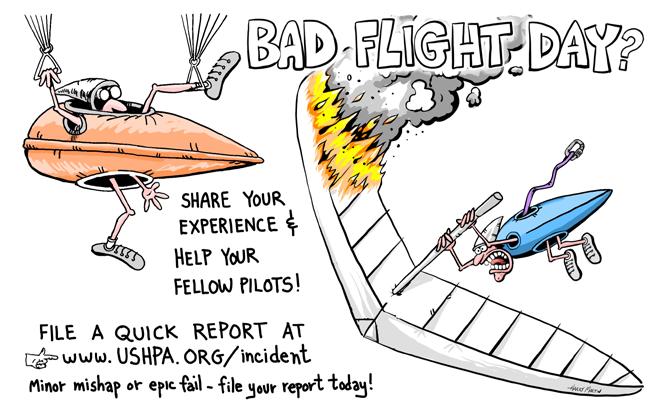
other side of the bed. Having a working awareness of what the trauma doctor was looking for and not hearing any big red flags, I was initially somewhat relieved.
The mechanism of injury and the kinetic energy involved, however, had everyone on high alert, and IVs, labs, trauma assessment, neuro exam, chest x-ray, ultrasound, and more were just a sampling of my trauma center experience. The wait for two different radiologists to read my head-to-toe CT scans was the most stressful part of the whole hospital stay. Sweet relief came as the doctor shook his head in disbelief that the only injuries they were able to find were three broken ribs.
: I got lucky on a number of different levels, and I am grateful I wasn’t alone. However, I have deep regret that I put myself, my family, and my community through this preventable accident. Free flight is such a beautiful sport, and for me, the culmination of a lifelong dream, calling, and completion of who I am deep inside. It is hard to share the painful failures. I have a magic backpack that can make me feel invincible, like I have a true superpower. But at
the end of the day, you win or lose by the way you choose.
Over the years, I have heard different pilots share their rules that help them decide whether to fly or not on a particular day. Some pilots hold a hard “Rule of 3.” The “Rule of 3” is a general mentality that if three things go wrong or are out of place in your normal pre-flight (think physically tired, missing InReach, crosswind), then it is probably a good idea not to fly. I always felt this was a bit superstitious and maybe even silly, but I may consider implementing such a structure if I decide to return to the skies.
My flying future holds a mix of trepidation and excitement. I may never entirely escape the shadow of that day, but I’m determined to let it shape me, not define me. I want to use this experience to reset my relationships, build a better life balance, and expand safety in my paragliding community. I may continue to fly, and if I do, it will be with a renewed sense of purpose. The sky will always call to me, but it will no longer be a playground without boundaries. It’s a place of respect, joy, deep community, and unwavering determination.
H1
H1
H1
H1 4 John Zugelder NC Jude Denton
H1 5 Chris Lamrock MI Rik Bouwmeester
H1 5 Robert Matukaitis MA Robert J. Hastings
H2 2 Jin Yang Brandon Ong CA Michael Briganti
H2 2 Cam Willie UT Theodore Hurley
H2 3 Roger Vecchio CA William C. Dydo
H2 4 Gabriel Dimitry FL Scott Schneider
H2 4 Kristen Hackbarth GA Scott Schneider
H2 4 Keith Hackbarth GA Scott Schneider
H2 4 John Inness AL Scott Schneider
H2 4 Andrew Karnowski KS William C. Dydo
H2 4 Andrew Leet FL Chair Safety and Training Committee
H2 4 Robert Niemeyer NC Scott Schneider
H2 4 Life Williams GA Matthew Taber
H2 5 Francisco Aybar TX Gordon Cayce
H2 5 Larry Berkowitz NY John Heiney
H2 5 Dwight Brenner OH John W. Alden
H2 5 Dominic luciano ON Matthew Taber
H3 2 Norio Eda CA Takeo Eda
H3 2 Christopher Lyall CA Patrick J. Denevan
H3 3 John Griffin CA William C. Dydo
H3 3 Micah Jackson CA Bob Steven Bendetson
H3 4 Scott Widener TN Jordan Stratton
H3 4 Debbie Wolford TN Scott Schneider
H3 5 Dion Santi IL Richard Thorp
H4 3 Michael Rodriguez AZ Dan DeWeese
H4 4 John Beebe AL Chair Safety and Training Committee
H4 4 Ephi Blanshey TN John Heiney
H4 5 Daniel Lavigne QC Matthew Taber
H4 5 Tavis Linsin MA Jonathan Atwood
P1 1 Siena Ballance WA Weaver Froelicher
P1 1 Brooke Matson HI Paul Gurrieri
P1 2 Kamran Ali CA Jeffrey J. Greenbaum
P1 2 Laura Byrd CA Jeffrey J. Greenbaum
P1 2 Wenbo ding CA Jeffrey J. Greenbaum
P1 2 Phil Monteith CA Chris Kennedy
P1 2 Peyton Murray CA Chris Kennedy
P1 3 Nick Gengozian CO Arias Anderson
P1 3 Simon Hunter CA Emily Wallace
P1 3 Parker Keil CA Jordan Neidinger
P1 3 Andrew Pearce CO Patrick Johnson
P1 3 Jamieson Slough CA Emily Wallace
P1 3 Dan Sommer CO Ernesto Martinez
P1 3 Jeffrey Worsham CA Emily Wallace
P1 4 Jakob Ivester TX Jason R. Laughlin
P1 5 Corey Dallaire UT Arias Anderson
P1 5 Timothy Eddy ME Salvatore Scaringe
P1 5 Ankit Jariwala MA Salvatore Scaringe
P2 1 Molly Briggs AK Christopher Gulden
P2 1 Joshua Brothers WA Austin Cox
P2 1 Alex Burkhart AK Christopher Gulden
P2 1 Alyssa Chapman WA Weaver Froelicher
P2 1 Corey Cooke WA Chris W. Santacroce
P2 1 Raymond Cooney HI Paul Gurrieri
P2 1 Griffin Culbeck AK Arias Anderson
P2 1 Michael Delay AK Kelly A. Kellar
P2 1 Justin Delgado MN Harry Sandoval
P2 1 Sam Forstag MT Christopher Grantham
P2 1 Nicco Garofalo WA Austin Cox
P2 1 Cole Gayan WA Chris W. Santacroce
P2 1 David Goldberg MT Andy Macrae
P2 1 Caylon Hackler HI Paul Gurrieri
P2 1 Philip Hohenlohe MT Andy Macrae
P2 1 Sylwester Jakubowski WA Patrick Kelly
P2 1 Arun Josyula WA Matt Senior
P2 1 Serena Killion OR Weaver Froelicher
Cort Jackson UT Jonathan Jefferies
P2 2 Khatchadour Khatchadourian CA Robert Black
P2 2 Tanner Leo CA Robert Black
P2 2 Wei Li CA Jesse L. Meyer
P2 2 Noah Link CA Jeffrey J. Greenbaum
P2 2 Auriana Mallory UT Chris W. Santacroce
2 Glen Maxson UT Eric Stratton P2 2 John Midgett CA Mike Fifield P2 2 Ryan Morgan UT Chris W. Santacroce P2 2 Rajneesh Raina CA Jeffrey J. Greenbaum P2 2 Spencer Stephens UT Jonathan Jefferies
P2 2 Darren Stuewe CA Jesse L. Meyer
P2 2 Duane Tuggle UT Nathan Alex Taylor
P2 2 Peter Volpe CA Jesse L. Meyer
P2 2 Garrett Wardell UT Chris W. Santacroce
P2 2 Kyle Weaver CA Robert Black
P2 2 Jonathan Weiss CA Robert Black
P2 2 Tzu-Hsien Yu CA Robert Black
P2 2 Yueming Zhang CA Robert Black
P2 3 Alek Aker CO Misha Banks
P2 3 Elizabeth Bedortha CA Christopher Gulden
P2 3 Gabriel Beryozkin CO Gregory Kelley
P2 3 Erika Binder CO Misha Banks
P2 3 Anne Blue CA Christopher Gulden
P2 3 Casey bollinger CA Chris W. Santacroce
P2 3 Beau Bratton CA Max Leonard Marien
P2 3 Ivan Bury CO Austin Fisher
P2 3 Toby Calhoun CA Christopher Grantham
P2 3 Jonathan Caniglia AZ Chandler Papas
P2 3 Rafael Carrillo CA Christopher Grantham
P2 3 Colin Casler NM Christopher Gulden
P2 3 Amelia Christensen CO Austin Fisher
P2 3 Noriko Coburn CA Emily Wallace
P2 3 Matt Cornell AZ Mitchell B. Neary
P2 3 David Herron CA Christopher Gulden
P2 3 Jamison Hubbard CO Misha Banks
P2 3 Bianca Idas CA Christopher Gulden
P2 3 Oliver Kraft CO Misha Banks
P2 3 Jeramy Larson CA Max Leonard Marien
P2 3 Rebecca Machen CO Misha Banks
P2 3 Michael Menhennet CA Jay Whiteaker
P2 3 Christian orendain CA Emily Wallace
P2 3 Robert Oxley AZ Chandler Papas
P2 3 Chansong Park CA Christopher Gulden
P2 3 Jaimin Patel AZ Chandler Papas
P2 3 William Priest CA Stephen Nowak
P2 3 Svetlana Rastrigina CA Christopher Grantham
P2 3 Brady Smith CO Misha Banks
P2 3 Gregory Smolarski CO Misha Banks
P2 3 Jack Summers CO Misha Banks
P2 3 Preston Tiff AZ Chandler Papas
P2 3 Gabe Tiger CA Christopher Gulden
P2 3 Eric Wustrow CO Austin Fisher
P2 4 Kayla Browning FL Chris W. Santacroce
P2 4 Adriano Caloiaro FL Max Leonard Marien
P2 4 Bryan Craig FL Patrick Kelly
P2 4 Johnny Dena FL Chandler Papas
P2 4 Mason Fereday LA Thomas McCormick
P2 4 Fracka Future TN Austin Kasserman
P2 4 Rohit Garg SC David Hanning
P2 4 Gregory Geiger NC Chris W. Santacroce
P2 4 Conor Hogan TX Christopher Grantham
P2 4 Chris Kennedy FL Christopher Gulden
P2 4 Joseph Kiernan GA Christopher Gulden
P2 4 Matthew Langie NC Austin Kasserman
P2 4 Fnu Najibullah GA Alejandro Albornoz
P2 4 Michael O'Donnell TN Austin Kasserman
P2 4 Matthew Rego GA Alejandro Albornoz
P2 4 Jeffrey St Aubin TN Alejandro Albornoz
P2 4 Donovan Sutton VA Thomas McCormick
P2 5 Jacob Bernstein
MA Christopher Grantham
P2 5 Amith Bokka IL Charles Chuck E. Gordon
P2 5 LaWayne Bontrager PA Andy Macrae
P2 5 Patrick Burke
P2 5 Evan Carmean
P2 5 Steven Conroy
P2 5 Ryan Dahlberg
MA Chris W. Santacroce
NH William H. Gottling
MA Ryan Patrick Kerschen
MA Stephen J. Mayer
P2 5 Chloe Fillettaz NY Salvatore Scaringe
P2 5 Zach Fluck PA Robert Black
P2 5 Jeffrey Horner OH Max Leonard Marien
P2 5 Craig Norconk MI Nathan Alex Taylor
P2 5 Matt Sale CT William H. Gottling
P2 5 Huzefa Siamwala WA Christopher J. Pyse
P2 5 William Tharp VT Calef Letorney
P2 5 Rebecca Tharp VT Calef Letorney
P2 5 Shiqi Wang IL Brian Clark
P3 1 Jacob Bick HI Paul Gurrieri
P3 1 Felix Bolongaro WA Matt Senior
P3 1 Dennis Davitt WA Mike Bomstad
P3 1 Cleveland Eells AK Juan Fernando Molano Madrid
P3 1 Mark H. Finley WA Calef Letorney
P3 1 Geoff Gilbert MT Joshua Phillips
P3 1 Robert Glasson WY Andy Macrae
P3 1 Johan Grav OR Randolph Ruffin
P3 1 Jason Hardrath OR Brian Kerr
P3 1 Jonathan Hutton WA Matt Senior
Take your ratings and expiration date everywhere you fly. View from the Members Area section of the USHPA website. Print, trim, and store in your wallet. Great for areas without cell coverage. Always available at www.USHPA.org
Save the PDF on your mobile device for easy reference.
P3 1 Thomas Jennings WY Jonathan Jefferies
P3 1 Diana Johnson WA Denise Reed
P3 1 Loren Landerholm WA Matt Senior
P3 1 Zach Lewis OR Matt Henzi
P3 1 Nathan Longhurst WA Jonathan Jefferies
P3 1 Yesha Maggi WA Matt Senior
P3 1 David Michalek OR Kelly A. Kellar
P3 1 Jeffrey Milhorn HI Pete Michelmore
P3 1 Thomas Salerno WY Jonathan Jefferies
P3 1 Justin Scorza HI Pete Michelmore
P3 1 Joanna Shell OR Kelly A. Kellar
P3 1 Amy Swan OR Denise Reed
P3 1 Christopher Swan OR Denise Reed
P3 1 Alex Taraghi OR Kelly A. Kellar
P3 1 Daniel Varsano AK Chris W. Santacroce
P3 1 Abigail Volkmann MT Cynthia Currie
P3 2 James Anderson UT Peter Williams
P3 2 Chaitanya Bandi CA Jeffrey J. Greenbaum
P3 2 Mark Berrett UT Jonathan Jefferies
P3 2 Abhijith Byrappa CA Jesse L. Meyer
P3 2 Spencer Coleman UT Jonathan Jefferies
P3 2 Artur Friedhoff CA Robert Black
P3 2 Xiaoxing Han CA David Oddy
P3 2 Evan Hartzell UT Chris W. Santacroce
P3 2 Scott Huff UT Jonathan Jefferies
P3 2 Brian Kellogg CA Jesse L. Meyer
P3 2 Dick Kikuyama CA David Oddy
P3 2 Robert Moore CA David Oddy
P3 2 Rithvik Narayan CA Jesse L. Meyer
P3 2 Michiel Segeren CA Jesse L. Meyer
P3 2 Keiler Jhoendri Serrato Rodriguez UT Chris W. Santacroce
P3 2 Jeremy Spiegel CA Robert Black
P3 2 Jeremy Sylvester UT Chris W. Santacroce
P3 2 Yunhan Wen CA Robert Black
P3 2 Chris Williams UT Arias Anderson
P3 2 Michael Yin CA Jesse L. Meyer
P3 3 Clark Arbogast CO Johannes Rath
P3 3 David Arnouk CA Max Leonard Marien
P3 3 Stewart Birmingham CO Douglas Brown
P3 3 Jared Deaton CA Jordan Neidinger
P3 3 Daniel Dunn AZ Chandler Papas
P3 3 Eric eisen CO Josh Waldrop
P3 3 Weston Harcourt CO Stephen J. Mayer
P3 3 Aaron Hudlemeyer NM Jonathan Jefferies
P3 3 Baptiste Humeau CO Dustin Miller
P3 3 Mike Jablonski CA Christopher Garcia
P3 3 Miles Jones CO Brian Doub
P3 3 Grayson Kemp CA Christopher Garcia
P3 3 Erika J. Klein CA Brian Petersen
P3 3 Jacob Larcher CO Gregory Kelley
P3 3 John Lee CA Max Leonard Marien
P3 3 Heidi Metzler CO Johannes Rath
P3 3 Joshua Moerer CA Marcello M. DeBarros
P3 3 Alex Rose CO Brian Doub
P3 3 Sebastian Sandner CO Johannes Rath
P3 3 Pacifica Sommers CO Dustin Miller
P3 3 Collin Trickel CO Brian Doub
P3 3 Drew Walters CO Etienne Pienaar
P3 4 Orlando Acevedo FL Chris W. Santacroce
P3 4 Mario Andreou GA Alejandro Albornoz
P3 4 Meghan Coffey NC Austin Kasserman
P3 4 Alex Coslow GA David Hanning
P3 4 Eder Espejo Jara GA Alejandro Albornoz
P3 4 Erik Grabowski TN Kelly Myrkle
P3 4 Juan Carlos Hernandez AR Steven Taylor Couch
P3 4 John Hill NC David Hanning
P3 4 Bradley Huie AL David Hanning
P3 4 David Marten VA Alejandro Albornoz
P3 4 Cayne Francis Mcmahen FL Kelly A. Kellar
P3 4 Michael OSullivan FL Juan Fernando Molano Madrid
P3 4 Sonja OSullivan FL Juan Fernando Molano Madrid
P3 4 Jon Winsley TN David Hanning
P3 5 Connie Campbell NH Calef Letorney
P3 5 David Dias MA Peter Williams
P3 5 Marc Elrick AB Paul Gurrieri
P3 5 Italy Garza MD Felix Figueroa
P3 5 Gus Kristiansen NY Chris W. Santacroce
P3 5 Eric Pressley WI Alex Peterson
P3 5 Janusz Rozanski IL Jaro Krupa
P3 5 Gregory Senko NH Salvatore Scaringe
P4 1 Evgenii Barbashov WA Matt Senior
P4 1 Chris Berquist HI Paul Gurrieri
P4 1 Nathaniel Geary AK Rob Sporrer
P4 1 Brett Gorbett OR Randolph Ruffin
P4 1 Iurii Gribkov WA William Pardis
P4 1 Michael C. Jensen WA Nicholas Greece
P4 1 Kea Jolicoeur WA Matt Senior
P4 1 Jeffrey Lang WY Pete Michelmore
P4 1 Steven Larsen WA Matt Senior
P4 1 Desmond Mills OR Matt Senior
P4 2 Robert Barlow CA Christopher Garcia
P4 2 Thorin Day CA Christopher Garcia
P4 2 Sean Devlin UT Arias Anderson
P4 2 Thomas Futral NV Chris W. Santacroce
P4 2 Nicholas Hill CA Jesse L. Meyer
P4 2 Mick Knutson UT Chris W. Santacroce
P4 2 Christopher Wood Koppl CA Robert Black
P4 2 Lionel Marks CA Ben Pedersen-Wedlock
P4 2 Muuo Wambua CA Jesse L. Meyer
P4 2 Patrick White CA David Oddy
P4 2 Tom Zhou CA Nathan Alex Taylor
P4 3 Sandra Acres CA Rob Sporrer
P4 3 Bob Ferris AZ Jordan Neidinger
P4 3 Jeremiah Haney CA Marcello M. DeBarros
P4 3 Anthony Karnezis AZ Rob Sporrer
P4 3 Eric Karnezis AZ Rob Sporrer
P4 3 Toni Leskela CO Emily Wallace
P4 3 Ethan Nyeste CO

“There is a constant exchange of energy between us and our surroundings, which can be recognized with enough awareness.”
BAS INST PG 5 Brent McCoy VT Calef Letorney
BAS INST HG 5 Christopher M. Toomey NY Paul Voight
BAS INST PG 5 Austin Kasserman OH Dale Covington
BAS INST HG 2 Philipp Neumann UT Oswaldo Lopez-Armas
BAS INST HG 5 Greg Saracino CT Paul Voight
BAS INST PG 3 Will Schaar III CO Gregory Kelley
BAS INST PG 4 Andrew Karnowski KS Rob Sporrer
BAS INST HG 1 Alexandra Jones OR Paul Voight
BAS INST PG 1 Hayden Waddle AK Rob Sporrer
BAS INST SF 2 Gary Begley UT Carl Weiseth
BAS INST SF 2 Arias Anderson UT Chris W. Santacroce
BAS INST PG 5 Karim Hamdi NY Max Leonard Marien
BAS INST PG 3 Jai Pal Singh Khalsa CA Hadi Golian
BAS INST PG 2 Kelly O. Foreman CA Max Leonard Marien
BAS INST HG 5 Tim Lewis NY Paul Voight
BAS INST PG 4 Jeff Butler MO Dale Covington
ADV INST PG 1 Peter Fay HI Paul Gurrieri
ADV INST PG 1 Craig C. Cunningham WA Brad Hill
ADV INST HG 1 Lj Omara WY Tiki Mashy
ADV INST HG 4 Richard Thorp TX Tiki Mashy
ADV INST HG 4 Pablo Indacochea GA Oswaldo Lopez-Armas
ADV INST PG 1 Randall Shane ID Rob Sporrer
ADV INST PG 3 Austin Cantrell CA Rob Sporrer
ADV INST HG 5 John W. Alden OH Paul Voight
ADV INST PG 3 Gregory Kelley CO Rob Sporrer
ADV INST PG 1 Paul Gurrieri HI Scott C. Harris
ADV INST HG 5 Paul Voight NY Jon C. Thompson
ADV INST HG 2 Robert Hugel CA Kurtis Carter
ADV INST PG 3 T Lee Kortsch NM Rob Sporrer
ADV INST PG 1 Paul C. Schaller-Franco HI Paul Gurrieri
ADV INST PG 3 David Frank CO Chris W. Santacroce
ADV INST HG 5 Tavis Linsin MA Paul Voight
ADV INST PG 3 Jordan Neidinger CA Jerome Daoust
ADV INST PG 3 Emily Wallace CA Kari L. Castle
ADV INST PG 4 Thomas Mistretta FL Gregory Kelley
ADV INST HG 4 William (Craig) Pearson NC Jon C. Thompson
ADV INST PG 2 Gever Tulley CA Kari L. Castle
ADV INST HG 3 Andrew T. Beem CA Kari L. Castle
ADV INST PG 3 William Purden-Jr CA Kari L. Castle
ADV INST HG 4 Robert J. Hastings PR Paul Voight
ADV INST PG 2 Gary Begley UT Chris W. Santacroce
ADV INST PG 5 Thomas McCormick NJ Chris W. Santacroce
ADV INST PG 2 Ed Stein CA Robert Black
ADV INST PG 1 Brian Howell WY Rob Sporrer
ADV INST PG 2 Randy Liggett CA Chris W. Santacroce
ADV INST PG 1 Brad Hill OR Gregory Kelley
ADV INST HG 4 William G. Vaughn NC Paul Voight
ADV INST PG 3 Steve Van-Fleet CA Kari L. Castle
ADV INST HG 2 Scott Seebass CA Kurtis Carter
ADV INST PG 3 Rob Sporrer CA Gregory Kelley
ADV INST PG 3 Chandler Papas AZ Chris W. Santacroce
ADV INST HG 5 Lukas Noah Shaanon MD Paul Voight
ADV INST HG 4 Tiki Mashy TX Paul Voight
ADV INST PG 1 Samuel Crocker OR Kari L. Castle
ADV INST PG 5 Calef Letorney VT Gregory Kelley
ADV INST PG 2 Mike Fifield CA Max Leonard Marien
ADV INST PG 1 Galen Kirkpatrick WA Rob Sporrer
ADV INST PG 2 Jesse L. Meyer CA Rob Sporrer
ADV INST HG 1 Rick Morrison ID Mel Glantz
ADV INST PG 1 David Dexter Binder HI Paul Gurrieri
ADV INST PG 3 Marty T. Devietti CA Rob Sporrer
ADV INST HG 5 Daniel C. Guido NY Matthew Taber
ADV INST PG 2 Julie Spiegler CA Kari L. Castle
ADV INST HG 4 Jon C. Thompson NC Paul Voight
ADV INST PG 3 Alejandro Palmaz CO Chris W. Santacroce
PL TECH2 HG 4 Jon C. Thompson NC Paul Voight
PL TECH2 HG 1 Mike Bomstad WA Jeff Beck
ST TECH1 HG 5 Norman W. Lesnow MI Paul Voight
ST TECH2 HG 5 Norman W. Lesnow MI Paul Voight
ST TECH2 HG 1 Mike Bomstad WA Jeff Beck
ST TECH2 HG 4 William (Craig) Pearson NC Jon C. Thompson
ST TECH2 HG 4 Jon C. Thompson NC Paul Voight
TECH1
TECH1
TECH1
TECH1
TECH1
TECH2
TECH2
TECH2
TECH2
TECH2
TECH2
TECH2
TECH2
PG 5 Richard McDermott IL Jaro Krupa
PG 2 Kelly O. Foreman CA Max Leonard Marien
PG 1 Taylor Maitri ID James MacDonald
PG 2 Chris Kennedy CA Randall Shane
PG 5 Andrey Kuznetsov MA Calef Letorney
PG 1 Taylor Maitri ID James MacDonald
PG 3 William Purden-Jr CA David W. Prentice
PG 4 Robert Lee SC Jaro Krupa
PG 5 Richard McDermott IL Jaro Krupa
PG 5 Andria Lea Monteleone IL Jaro Krupa
PG 2 James MacDonald CA Randall Shane
PG 5 Dan Deleo VT Calef Letorney
PG 5 Thomas McCormick NJ Chris W. Santacroce
NAA Encourages pilots of all levels of experience to set records. Dozens of records are established each year. Know the rules before you fly.
Your FAI Sporting license must be valid.
Your Official Observer must not only be a member of USHPA, they must be independent and not be perceived to have a conflict of interest.
Initial notification of a record claim must be filed via the NAA web site within 72 hours of the attempt.
Learn more at naa.aero/records

In order to provide an up-to-date event list, USHPA Pilot no longer prints events in the quarterly magazine. Please scan the QR code above to go straight to it or visit the USHPA website at: ushpa.org/calendar
